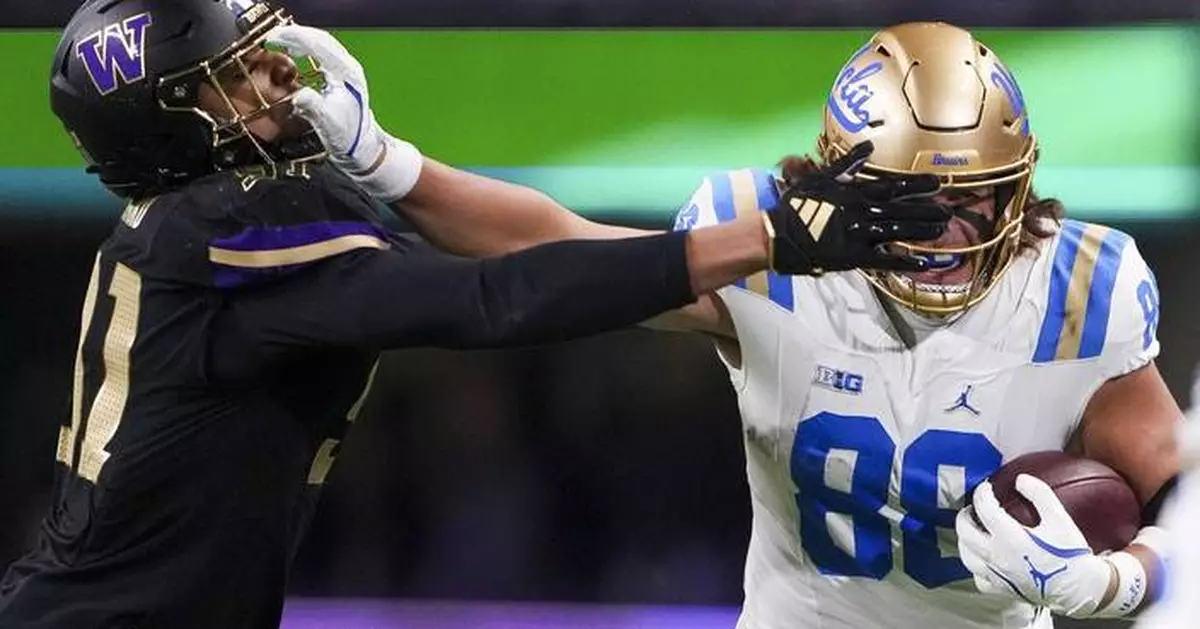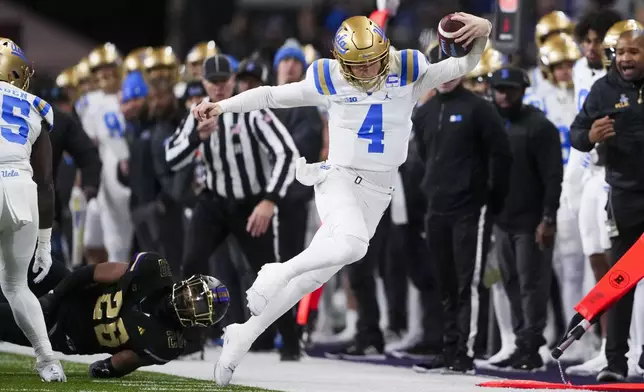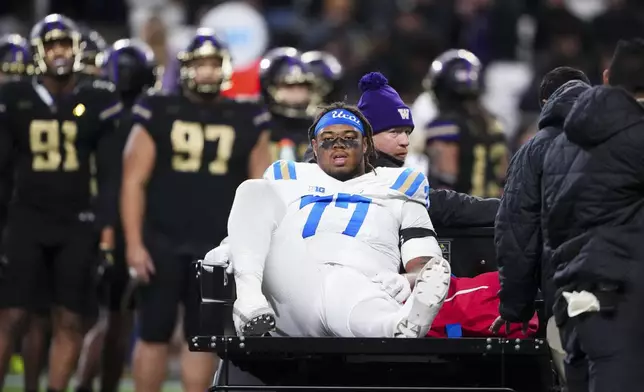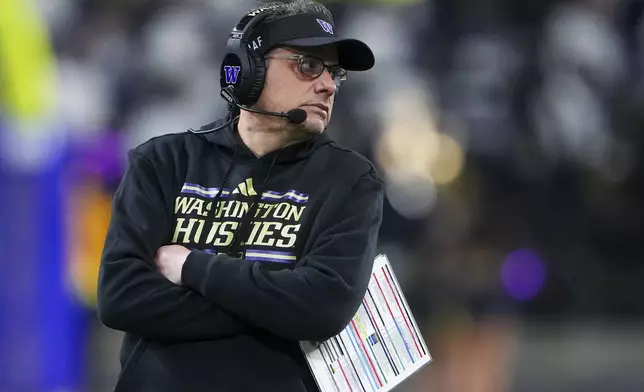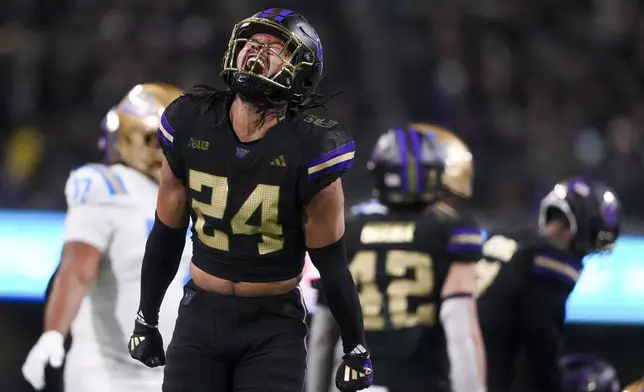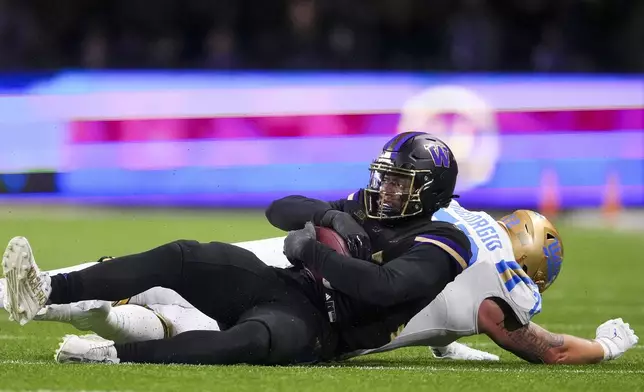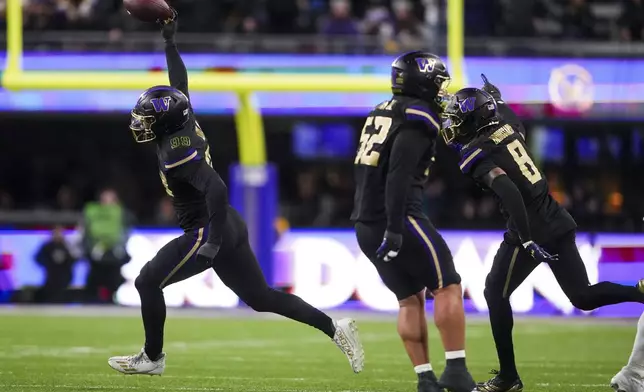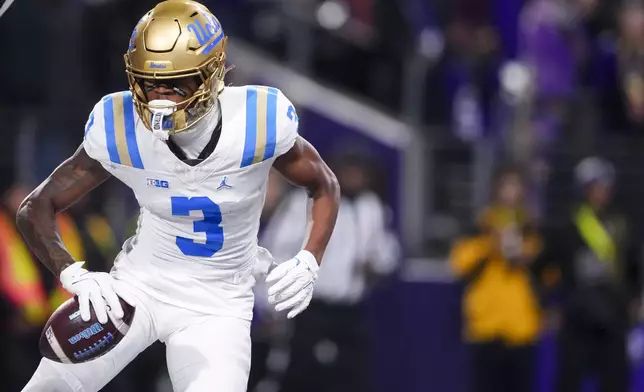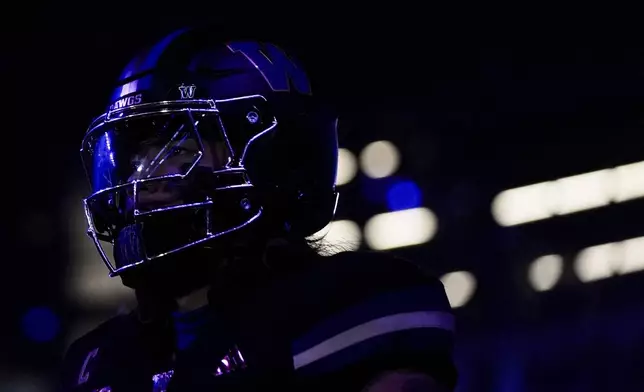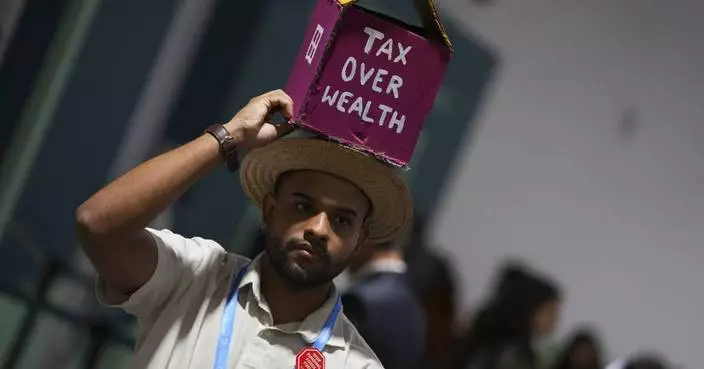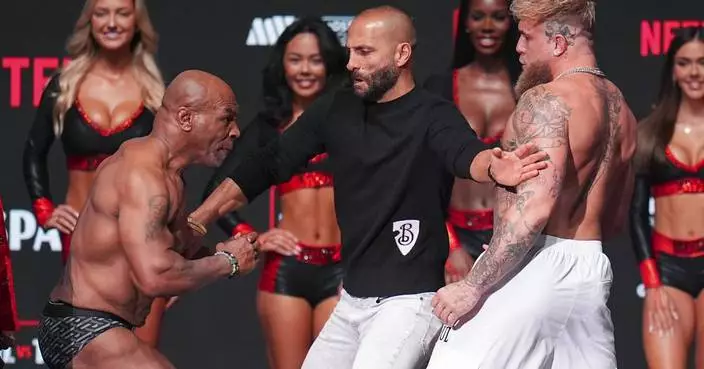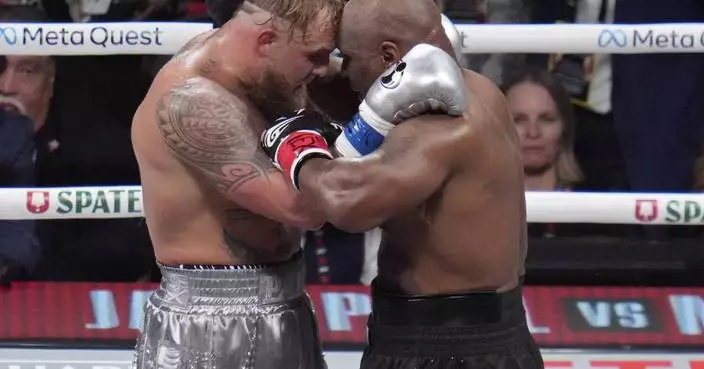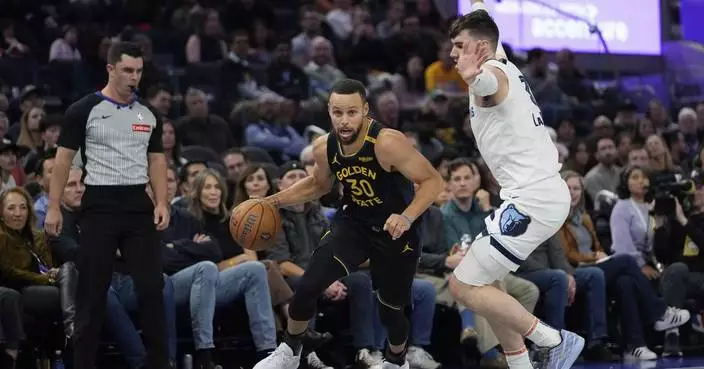SEATTLE (AP) — Demond Williams Jr. replaced starting quarterback Will Rogers, leading three second-half game-securing scoring drives, and Washington beat UCLA 31-19 on Friday night to clinch bowl eligibility.
Jonah Coleman added 95 rushing yards and two TDs as the Huskies won for the second time in three games and pushed their home win streak to 20 games.
Click to Gallery
Washington running back Jonah Coleman scores a touchdown against UCLA defensive back Jaylin Davies (6) and defensive back Bryan Addison (4) during the first half of an NCAA college football game Friday, Nov. 15, 2024, in Seattle. (AP Photo/Lindsey Wasson)
Washington running back Jonah Coleman (1) celebrates his touchdown with offensive lineman Drew Azzopardi (74) as UCLA defensive back Bryan Addison (4) looks away during the first half of an NCAA college football game Friday, Nov. 15, 2024, in Seattle. (AP Photo/Lindsey Wasson)
UCLA quarterback Ethan Garbers looks to throw against Washington during the first half of an NCAA college football game Friday, Nov. 15, 2024, in Seattle. (AP Photo/Lindsey Wasson)
UCLA running back T.J. Harden (25) runs the ball against Washington during the first half of an NCAA college football game Friday, Nov. 15, 2024, in Seattle. (AP Photo/Lindsey Wasson)
UCLA tight end Moliki Matavao is tackled by Washington linebacker Alphonzo Tuputala (11) and linebacker Carson Bruener, right, during the first half of an NCAA college football game Friday, Nov. 15, 2024, in Seattle. (AP Photo/Lindsey Wasson)
Washington edge Isaiah Ward, top, and defensive tackle Sebastian Valdez (50) sack UCLA quarterback Ethan Garbers (4) during the first half of an NCAA college football game Friday, Nov. 15, 2024, in Seattle. (AP Photo/Lindsey Wasson)
UCLA head coach DeShaun Foster looks on from the sideline against Washington during the first half of an NCAA college football game Friday, Nov. 15, 2024, in Seattle. (AP Photo/Lindsey Wasson)
UCLA quarterback Ethan Garbers (4) runs the ball against Washington linebacker Khmori House (28) during the first half of an NCAA college football game Friday, Nov. 15, 2024, in Seattle. (AP Photo/Lindsey Wasson)
UCLA offensive lineman Jaylan Jeffers is carted off the field with an injury during the first half of an NCAA college football game against Washington, Friday, Nov. 15, 2024, in Seattle. (AP Photo/Lindsey Wasson)
Washington head coach Jedd Fisch stands on the sideline during the first half of an NCAA college football game against UCLA, Friday, Nov. 15, 2024, in Seattle. (AP Photo/Lindsey Wasson)
Washington head coach Jedd Fisch talks with quarterback Will Rogers during the first half of an NCAA college football game against UCLA, Friday, Nov. 15, 2024, in Seattle. (AP Photo/Lindsey Wasson)
Washington quarterback Will Rogers throws against UCLA during the first half of an NCAA college football game Friday, Nov. 15, 2024, in Seattle. (AP Photo/Lindsey Wasson)
Washington safety Makell Esteen reacts after a tackle against UCLA during the first half of an NCAA college football game Friday, Nov. 15, 2024, in Seattle. (AP Photo/Lindsey Wasson)
UCLA place kicker Mateen Bhaghani kicks a field goal against Washington during the first half of an NCAA college football game Friday, Nov. 15, 2024, in Seattle. (AP Photo/Lindsey Wasson)
Washington defensive lineman Russell Davis II recovers a fumble against UCLA offensive lineman Garrett DiGiorgio during the first half of an NCAA college football game Friday, Nov. 15, 2024, in Seattle. (AP Photo/Lindsey Wasson)
UCLA wide receiver Kwazi Gilmer (3) reacts to scoring a touchdown against Washington during the first half of an NCAA college football game Friday, Nov. 15, 2024, in Seattle. (AP Photo/Lindsey Wasson)
Washington defensive lineman Russell Davis II, left, reacts after recovering a fumble against UCLA during the first half of an NCAA college football game Friday, Nov. 15, 2024, in Seattle. (AP Photo/Lindsey Wasson)
UCLA wide receiver Kwazi Gilmer (3) reacts to scoring a touchdown against Washington during the first half of an NCAA college football game Friday, Nov. 15, 2024, in Seattle. (AP Photo/Lindsey Wasson)
Washington offensive lineman Gaard Memmelaar (64) celebrates with tight end Keleki Latu after Latu's touchdown against UCLA during the first half of an NCAA college football game Friday, Nov. 15, 2024, in Seattle. (AP Photo/Lindsey Wasson)
Washington tight end Keleki Latu (85) runs for a touchdown against UCLA linebacker Kain Medrano (20) and defensive back Ramon Henderson (11) during the first half of an NCAA college football game Friday, Nov. 15, 2024, in Seattle. (AP Photo/Lindsey Wasson)
UCLA quarterback Ethan Garbers (4) reacts to throwing a touchdown pass to wide receiver Kwazi Gilmer during the first half of an NCAA college football game against Washington, Friday, Nov. 15, 2024, in Seattle. (AP Photo/Lindsey Wasson)
Washington safety Kamren Fabiculanan walks out to the field before an NCAA college football game against UCLA, Friday, Nov. 15, 2024, in Seattle. (AP Photo/Lindsey Wasson)
UCLA quarterback Ethan Garbers (4) reacts after throwing a touchdown to wide receiver Kwazi Gilmer (3) against Washington during the first half of an NCAA college football game Friday, Nov. 15, 2024, in Seattle. (AP Photo/Lindsey Wasson)
Washington running back Jonah Coleman (1) runs the ball on his way to a touchdown against UCLA defensive back Bryan Addison (4) during the first half of an NCAA college football game Friday, Nov. 15, 2024, in Seattle. (AP Photo/Lindsey Wasson)
UCLA tight end Moliki Matavao (88) stiff-arms Washington edge Isaiah Ward during the first half of an NCAA college football game Friday, Nov. 15, 2024, in Seattle. (AP Photo/Lindsey Wasson)
“Full House, great crowd, great energy and to be 6-0 at home with a 20-game win streak is pretty amazing,” UW coach Jedd Fisch said. “And we're looking forward to taking that win streak into next season. ”
Williams led the Huskies (6-5, 4-4 Big Ten) to a field goal and two touchdowns, including a 2-yard touchdown pass to Decker DeGraaf with 5:44 left in the game to seal the victory over the Bruins (4-6, 3-5). Rogers helped UW to a 14-13 halftime lead, but threw interceptions on the Huskies’ first two drives of the second half.
UW’s defense held UCLA to just three points after those turnovers, making several big plays and scoring 10 points off turnovers to secure the win. The Steve Belichick-coached defense forced and recovered two fumbles and sacked UCLA quarterback Ethan Garbers six times in the victory, including on third and fourth down to end a late threat.
Rogers was 13 of 21 for 115 yards and a touchdown when he was pulled from the game after throwing interceptions to Devin Kirkwood and Kain Medrano. The first bounced off his receiver’s hands, but the second was a bad throw into triple coverage.
“I thought Will did a nice job there getting us to the 14 and then things were just not going as well as I would have liked them to,” Fisch said. “And I thought it was the right time to give (Williams) that opportunity.”
Williams completed 7 of 8 passes for 67 yards and a score and scrambled for 31 more.
Russell Davis II helped set up UW’s first two scores with two of his three sacks of Garbers. The first was followed by a 17-yard shanked punt that gave the Huskies first down at UCLA’s 36. Jonah Coleman capped a short drive with a 15-yard score and a 7-0 lead.
Coleman struggled to find room on his first few carries, then decided to slow down and wait for his blocks. He was rewarded with a gaping hole for his first score.
“I just had to go back to the basics,” Coleman said.
The performance gave him 1,008 yards and nine touchdowns this season.
“Jonah Coleman has gone over 1,000 yards on the season,” Fisch said. “I'm so proud of him. That's the No. 7 rushing defense in the country.”
Davis helped make it 14-3 with a strip sack of former UW quarterback Garbers and fumble recovery midway through the first quarter. Rogers threw an interception in the end zone on the ensuing drive. But Bryan Addison’s pick was wiped away by a roughing the passer call on Oluwafemi Oladejo. Rogers took advantage of the second chance with an 8-yard scoring toss to Keleki Latu for a 14-3 lead.
Garbers completed 27 of 44 for 267 yards and two scores.
The Bruins need two more wins to reach bowl eligibility. Coach DeShaun Foster thinks UCLA should be motivated with games against USC and Fresno State left.
“This next game, there’s not much you need to tell them,” Foster said. “They understand what kind of game we have coming up, so they should be a little upset and eager to get out on the field.”
THE TAKEAWAY
UCLA: The Bruins still have a shot at making a bowl with winnable games left on the schedule (they finish with Fresno State). But they’ll need to play better than this. There was no running game to speak of – they averaged 1.6 yards per carry - and if Garbers hadn’t been a magician on third down, converting 10 of 19, this game would have been over in the first half.
Washington: The win made the Huskies bowl eligible in their first season under Fisch, something that looked like a long shot as UW lost three of four coming into the game. That will buoy the Huskies as they prepare for their biggest test of the season.
QB DECISION
Fisch declined to name a starter for the upcoming game against No. 1 Oregon.
“I'm going to use the bye week for that and certainly announce that at the right time - or not, and let them defend two quarterbacks,” he said with a laugh.
UP NEXT
UCLA: The Bruins host crosstown rival USC on Saturday, Nov. 23.
Washington: The Huskies close the season at No. 1 Oregon on Nov. 30.
——
Get poll alerts and updates on the AP Top 25 throughout the season. Sign up here. AP college football: https://apnews.com/hub/ap-top-25-college-football-poll and https://apnews.com/hub/college-football

Washington running back Jonah Coleman scores a touchdown against UCLA defensive back Jaylin Davies (6) and defensive back Bryan Addison (4) during the first half of an NCAA college football game Friday, Nov. 15, 2024, in Seattle. (AP Photo/Lindsey Wasson)
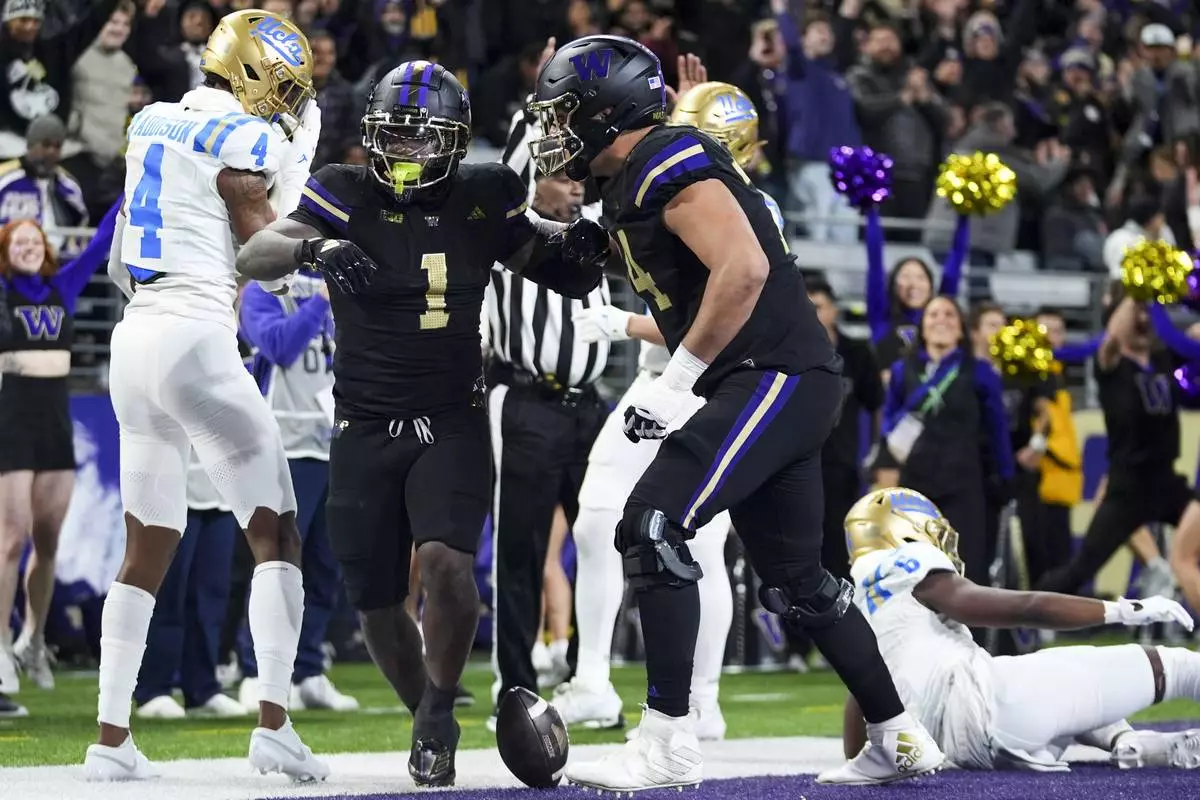
Washington running back Jonah Coleman (1) celebrates his touchdown with offensive lineman Drew Azzopardi (74) as UCLA defensive back Bryan Addison (4) looks away during the first half of an NCAA college football game Friday, Nov. 15, 2024, in Seattle. (AP Photo/Lindsey Wasson)

UCLA quarterback Ethan Garbers looks to throw against Washington during the first half of an NCAA college football game Friday, Nov. 15, 2024, in Seattle. (AP Photo/Lindsey Wasson)
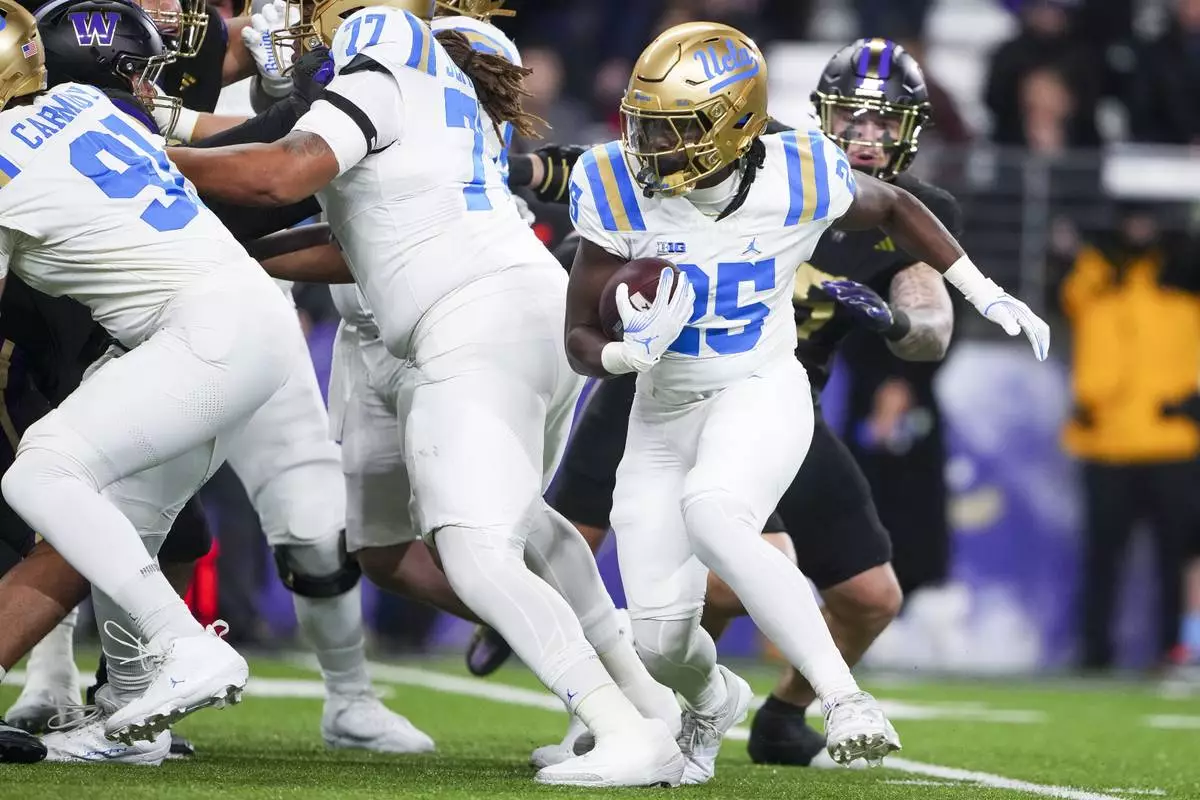
UCLA running back T.J. Harden (25) runs the ball against Washington during the first half of an NCAA college football game Friday, Nov. 15, 2024, in Seattle. (AP Photo/Lindsey Wasson)
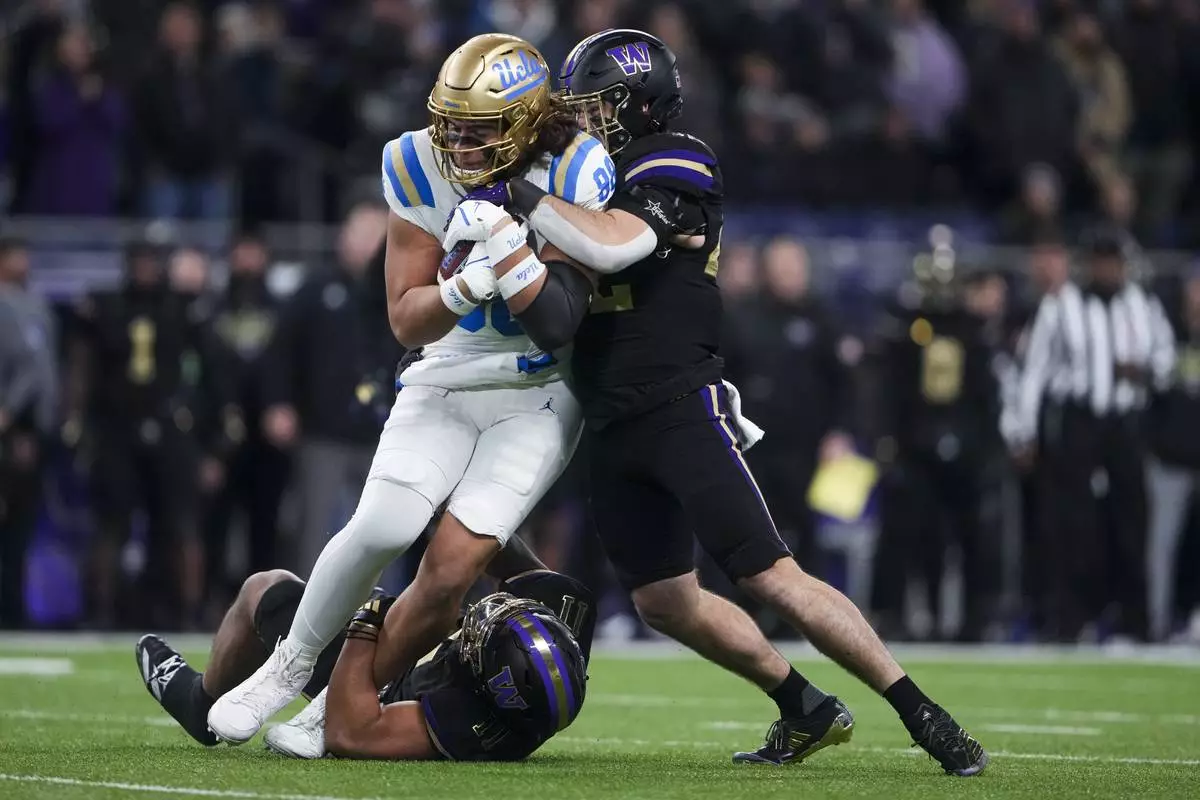
UCLA tight end Moliki Matavao is tackled by Washington linebacker Alphonzo Tuputala (11) and linebacker Carson Bruener, right, during the first half of an NCAA college football game Friday, Nov. 15, 2024, in Seattle. (AP Photo/Lindsey Wasson)
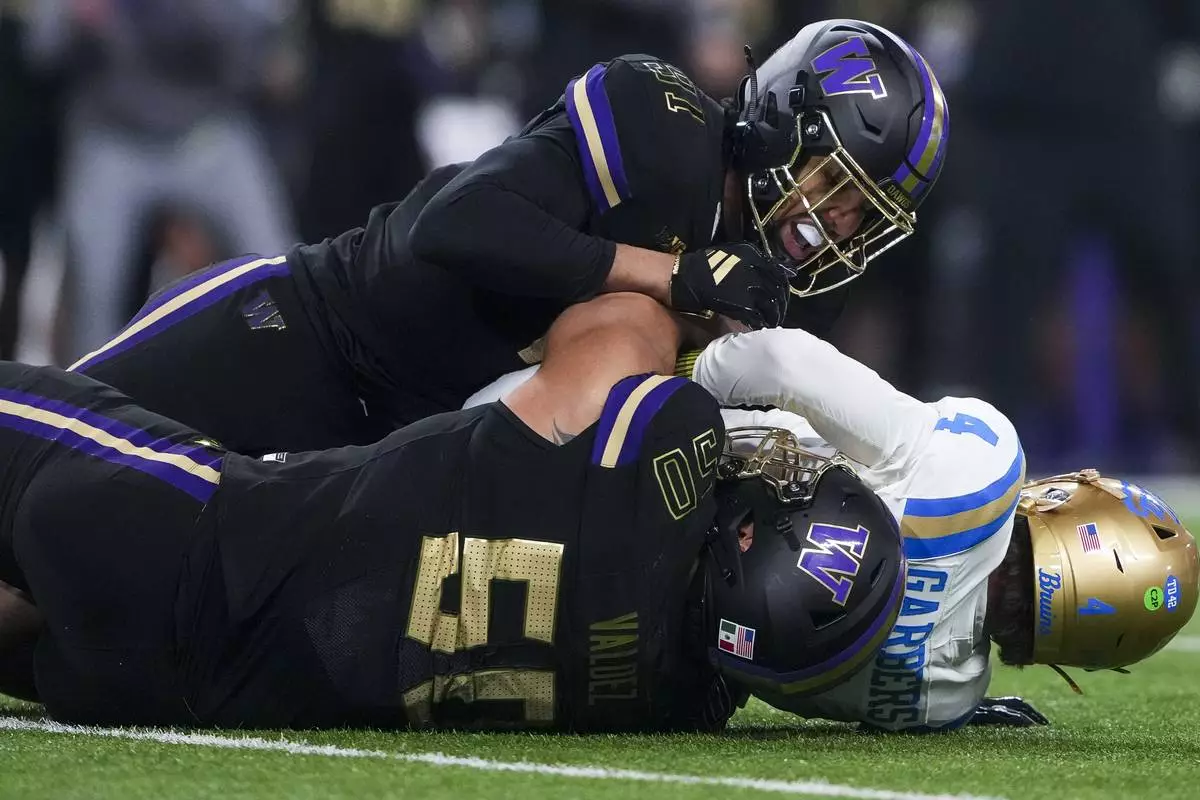
Washington edge Isaiah Ward, top, and defensive tackle Sebastian Valdez (50) sack UCLA quarterback Ethan Garbers (4) during the first half of an NCAA college football game Friday, Nov. 15, 2024, in Seattle. (AP Photo/Lindsey Wasson)
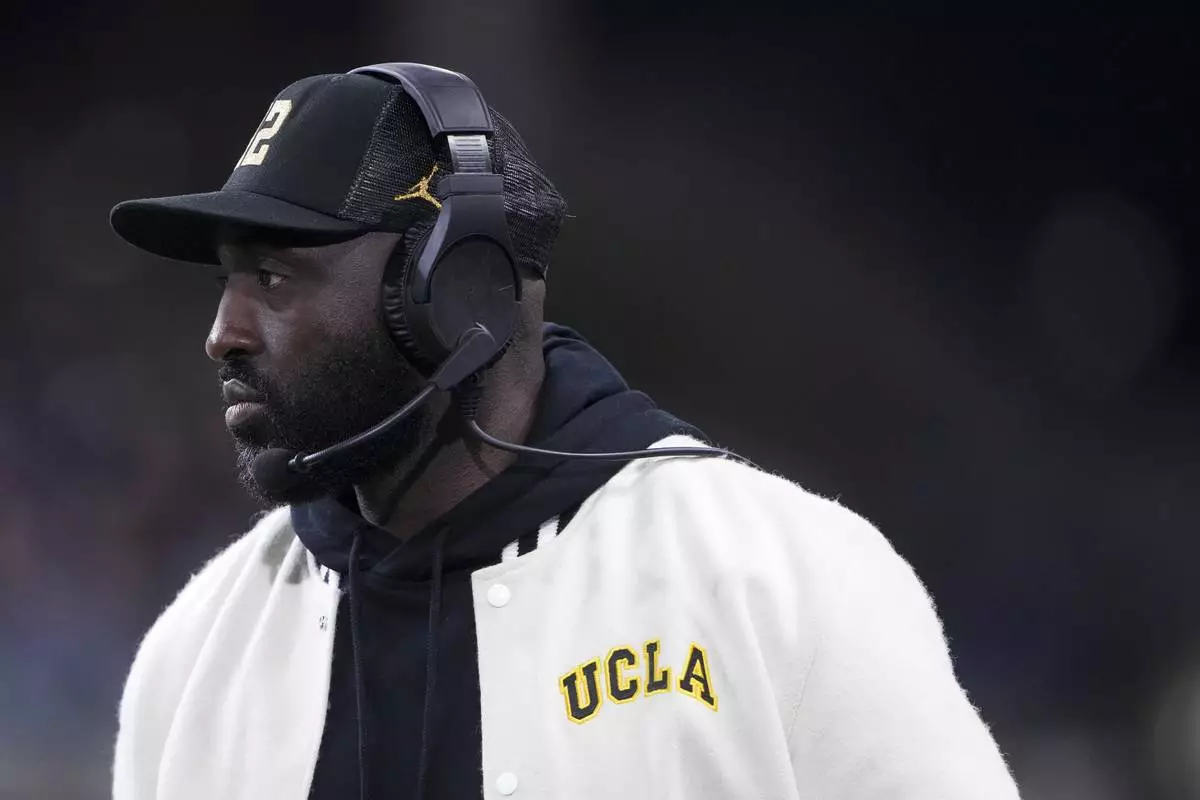
UCLA head coach DeShaun Foster looks on from the sideline against Washington during the first half of an NCAA college football game Friday, Nov. 15, 2024, in Seattle. (AP Photo/Lindsey Wasson)

UCLA quarterback Ethan Garbers (4) runs the ball against Washington linebacker Khmori House (28) during the first half of an NCAA college football game Friday, Nov. 15, 2024, in Seattle. (AP Photo/Lindsey Wasson)

UCLA offensive lineman Jaylan Jeffers is carted off the field with an injury during the first half of an NCAA college football game against Washington, Friday, Nov. 15, 2024, in Seattle. (AP Photo/Lindsey Wasson)

Washington head coach Jedd Fisch stands on the sideline during the first half of an NCAA college football game against UCLA, Friday, Nov. 15, 2024, in Seattle. (AP Photo/Lindsey Wasson)
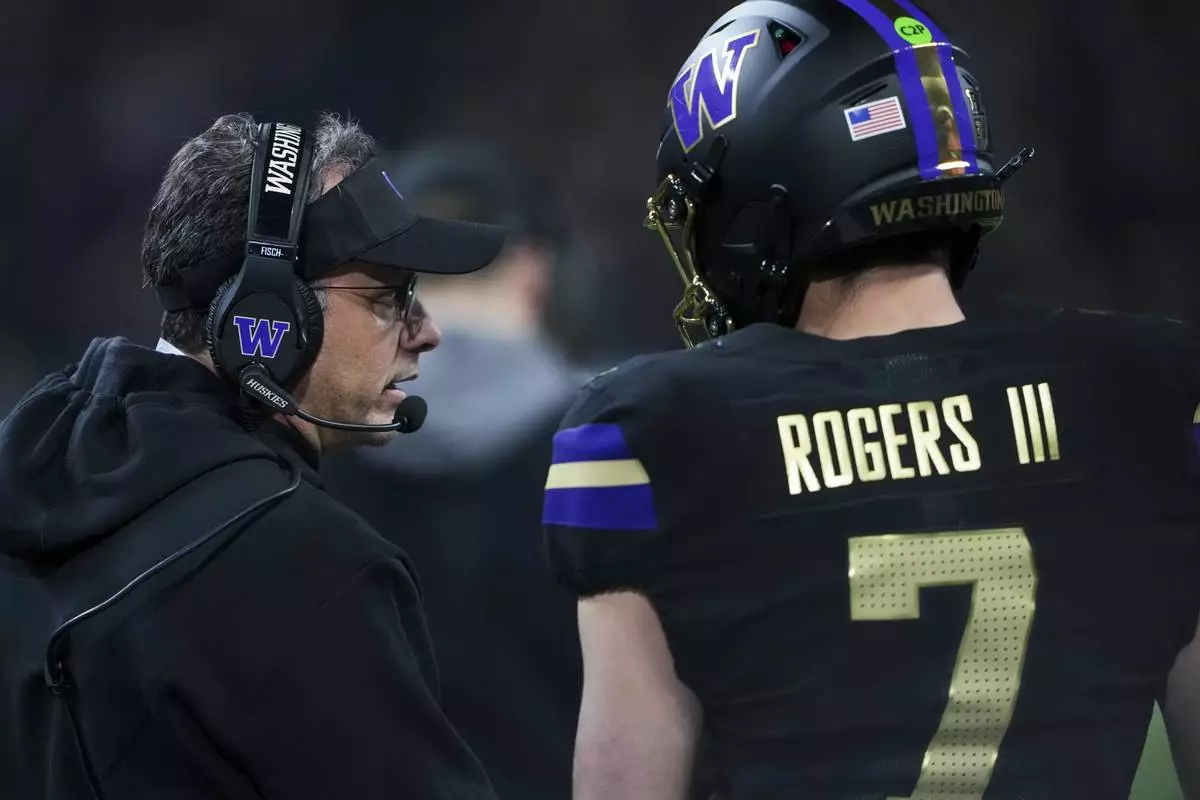
Washington head coach Jedd Fisch talks with quarterback Will Rogers during the first half of an NCAA college football game against UCLA, Friday, Nov. 15, 2024, in Seattle. (AP Photo/Lindsey Wasson)

Washington quarterback Will Rogers throws against UCLA during the first half of an NCAA college football game Friday, Nov. 15, 2024, in Seattle. (AP Photo/Lindsey Wasson)

Washington safety Makell Esteen reacts after a tackle against UCLA during the first half of an NCAA college football game Friday, Nov. 15, 2024, in Seattle. (AP Photo/Lindsey Wasson)
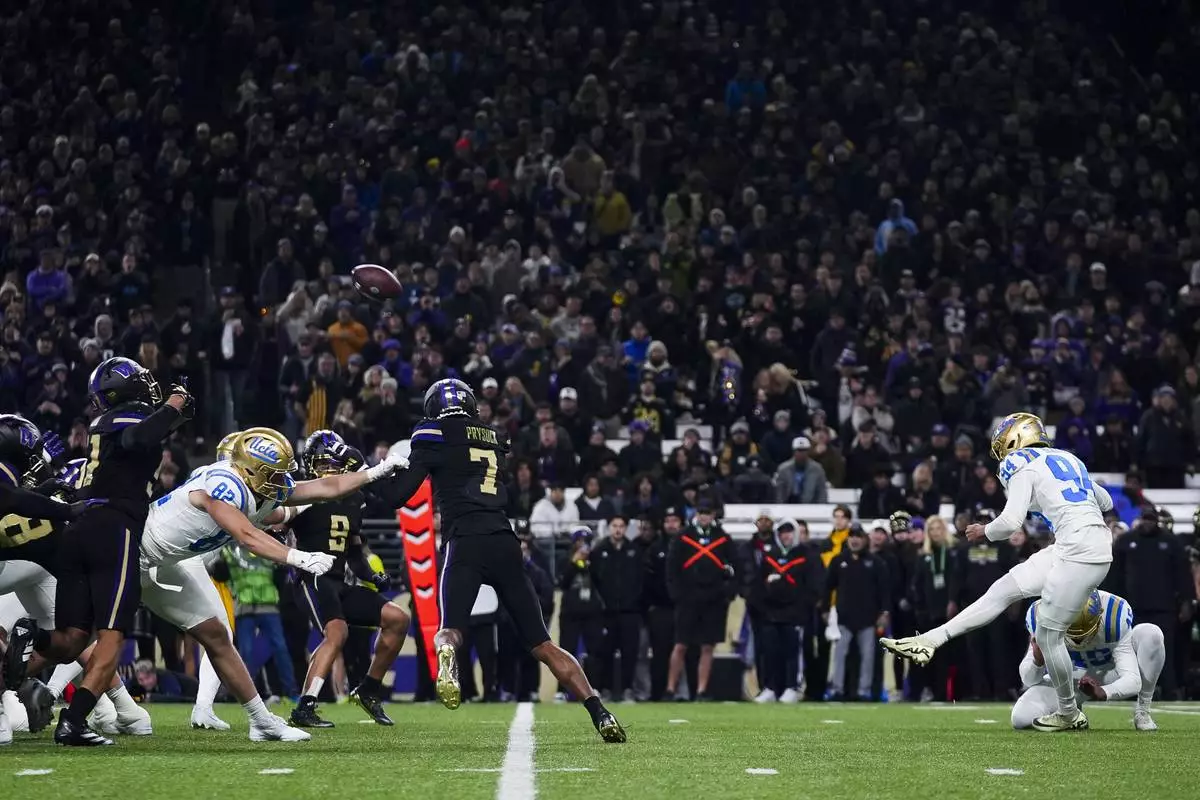
UCLA place kicker Mateen Bhaghani kicks a field goal against Washington during the first half of an NCAA college football game Friday, Nov. 15, 2024, in Seattle. (AP Photo/Lindsey Wasson)

Washington defensive lineman Russell Davis II recovers a fumble against UCLA offensive lineman Garrett DiGiorgio during the first half of an NCAA college football game Friday, Nov. 15, 2024, in Seattle. (AP Photo/Lindsey Wasson)
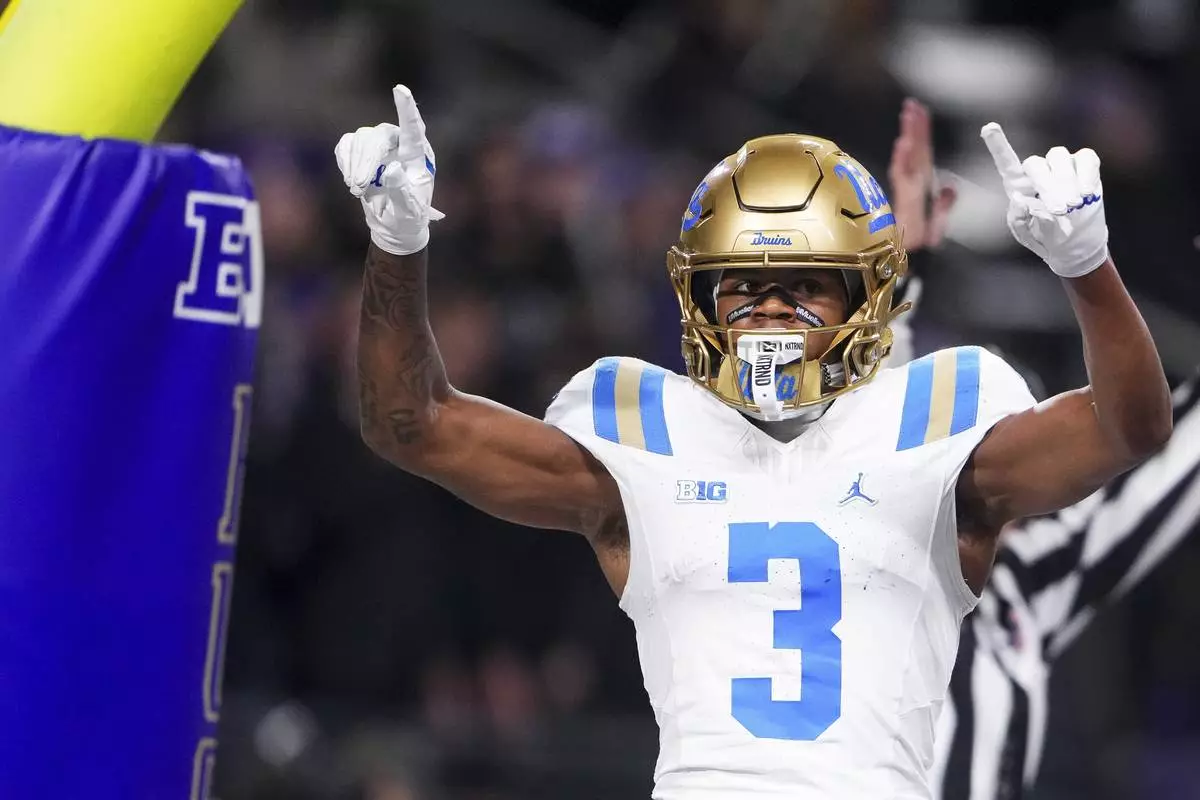
UCLA wide receiver Kwazi Gilmer (3) reacts to scoring a touchdown against Washington during the first half of an NCAA college football game Friday, Nov. 15, 2024, in Seattle. (AP Photo/Lindsey Wasson)

Washington defensive lineman Russell Davis II, left, reacts after recovering a fumble against UCLA during the first half of an NCAA college football game Friday, Nov. 15, 2024, in Seattle. (AP Photo/Lindsey Wasson)

UCLA wide receiver Kwazi Gilmer (3) reacts to scoring a touchdown against Washington during the first half of an NCAA college football game Friday, Nov. 15, 2024, in Seattle. (AP Photo/Lindsey Wasson)
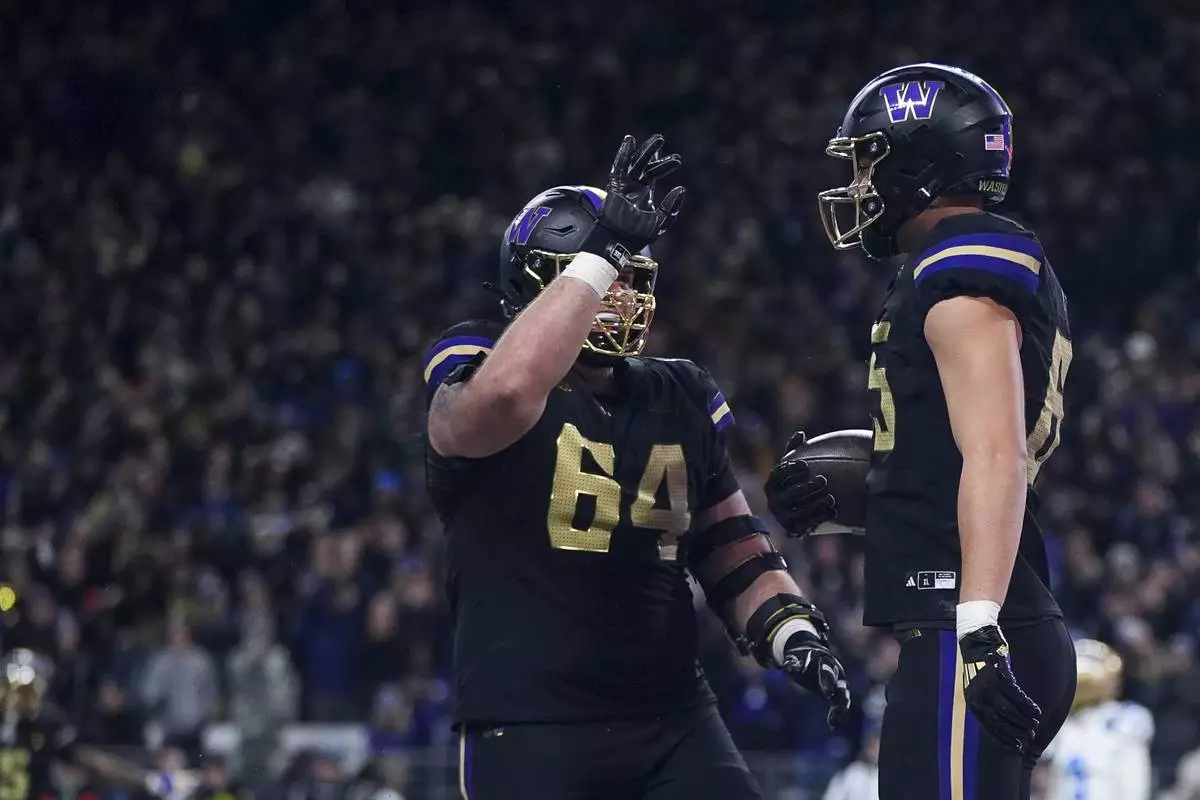
Washington offensive lineman Gaard Memmelaar (64) celebrates with tight end Keleki Latu after Latu's touchdown against UCLA during the first half of an NCAA college football game Friday, Nov. 15, 2024, in Seattle. (AP Photo/Lindsey Wasson)
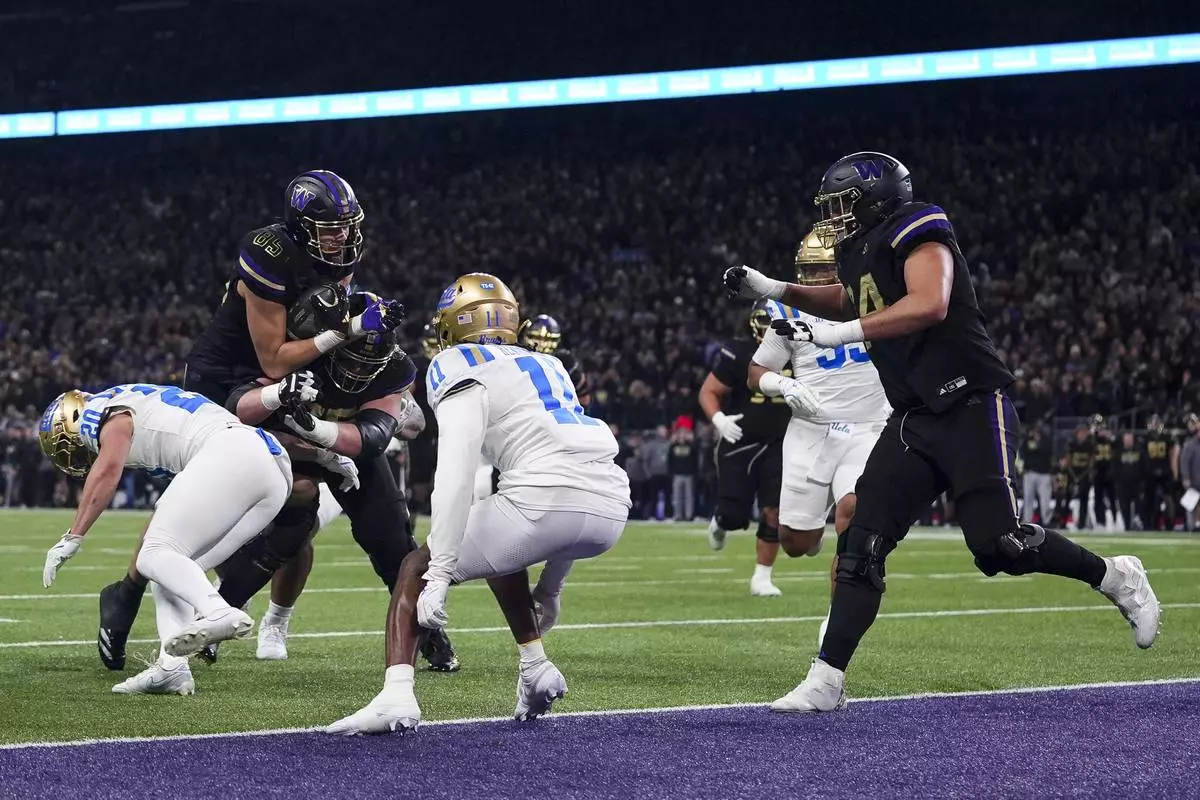
Washington tight end Keleki Latu (85) runs for a touchdown against UCLA linebacker Kain Medrano (20) and defensive back Ramon Henderson (11) during the first half of an NCAA college football game Friday, Nov. 15, 2024, in Seattle. (AP Photo/Lindsey Wasson)
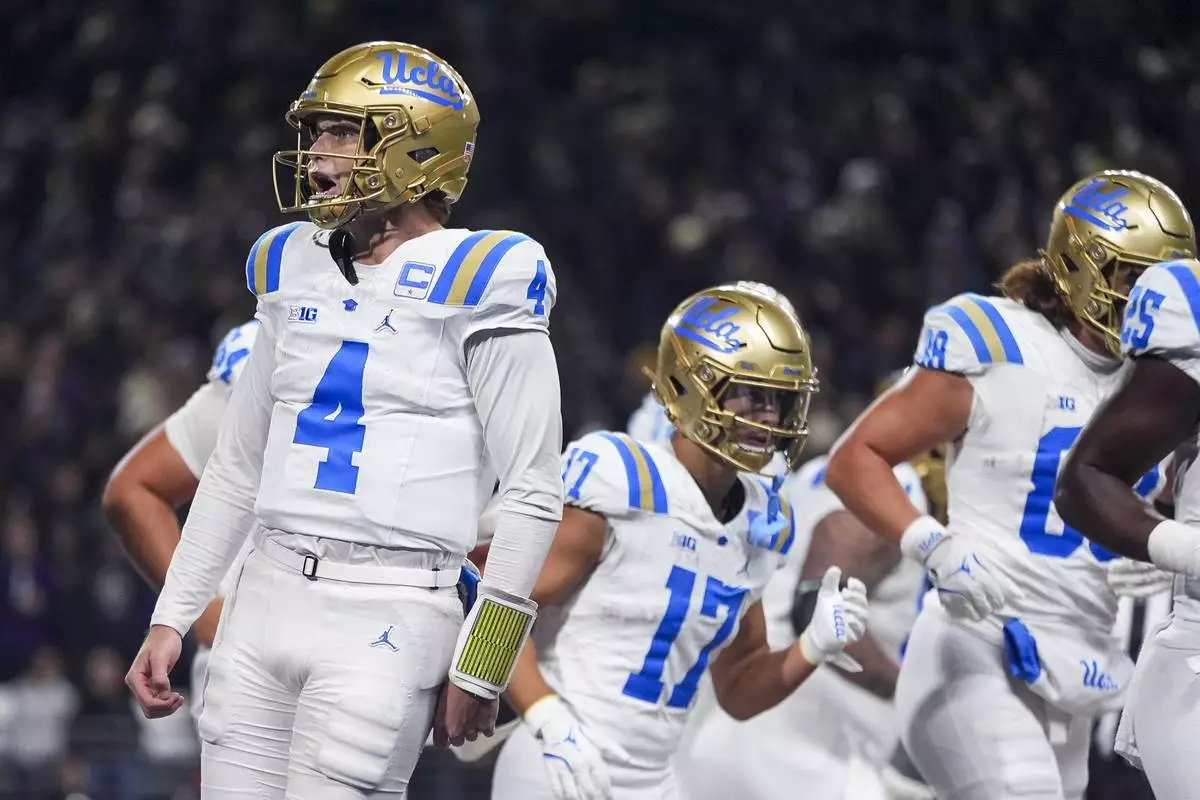
UCLA quarterback Ethan Garbers (4) reacts to throwing a touchdown pass to wide receiver Kwazi Gilmer during the first half of an NCAA college football game against Washington, Friday, Nov. 15, 2024, in Seattle. (AP Photo/Lindsey Wasson)

Washington safety Kamren Fabiculanan walks out to the field before an NCAA college football game against UCLA, Friday, Nov. 15, 2024, in Seattle. (AP Photo/Lindsey Wasson)
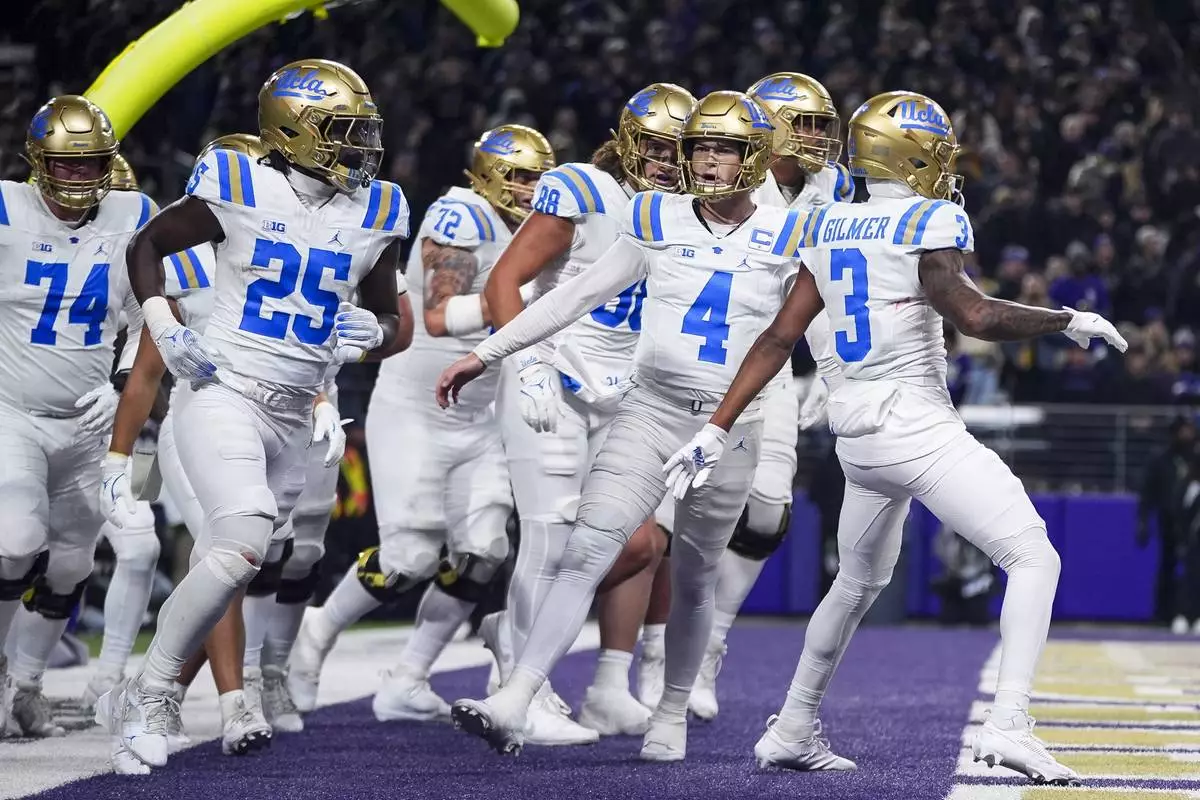
UCLA quarterback Ethan Garbers (4) reacts after throwing a touchdown to wide receiver Kwazi Gilmer (3) against Washington during the first half of an NCAA college football game Friday, Nov. 15, 2024, in Seattle. (AP Photo/Lindsey Wasson)
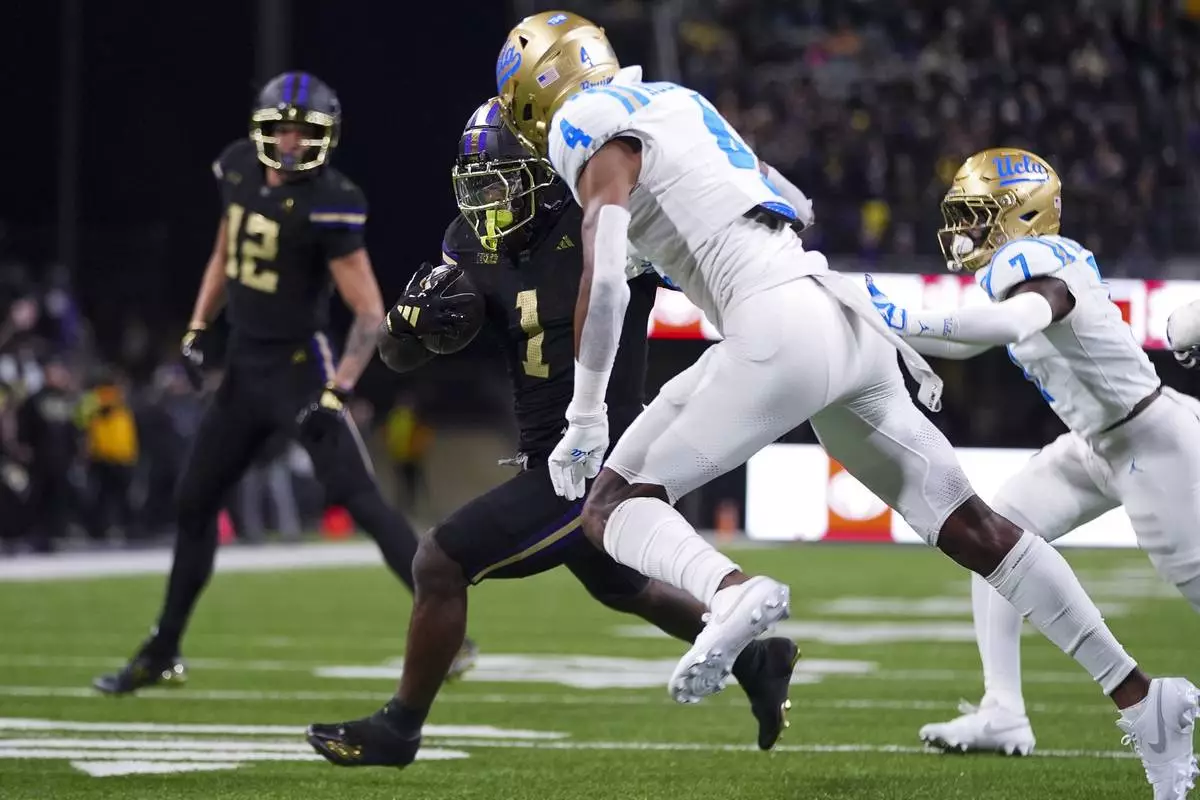
Washington running back Jonah Coleman (1) runs the ball on his way to a touchdown against UCLA defensive back Bryan Addison (4) during the first half of an NCAA college football game Friday, Nov. 15, 2024, in Seattle. (AP Photo/Lindsey Wasson)
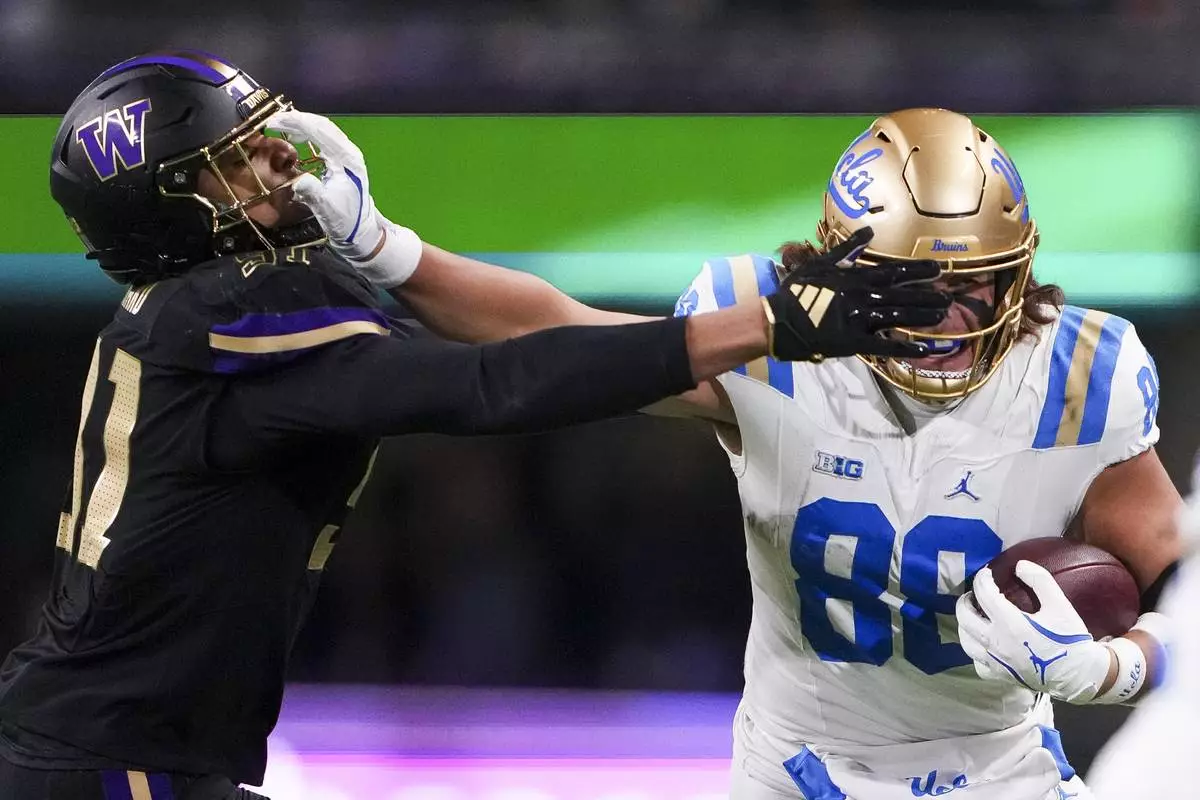
UCLA tight end Moliki Matavao (88) stiff-arms Washington edge Isaiah Ward during the first half of an NCAA college football game Friday, Nov. 15, 2024, in Seattle. (AP Photo/Lindsey Wasson)
KYIV, Ukraine (AP) — At a secretive factory in Russia's central grasslands, engineers are manufacturing hundreds of decoy drones meant to overwhelm Ukrainian defenses as they try to protect against a horrific new weapon, an Associated Press investigation has found.
The plant at Russia’s Alabuga Special Economic Zone recently started churning out thermobaric drones alongside the decoys, the investigation found. The thermobaric warheads create a vortex of high pressure and heat that can penetrate thick walls. They suck out all the oxygen in their path, and have a fearsome reputation because of the injuries inflicted even outside the initial blast site: Collapsed lungs, crushed eyeballs, brain damage.
Russia came up with the plan for decoys in late 2022 and codenamed it Operation False Target, according to a person familiar with Russia’s drone production who spoke on condition of anonymity because the industry is highly sensitive. The idea was to launch armed drones along with dozens of decoys, sometimes stuffed with rags or foam, and indistinguishable on radar from those carrying real bombs. Ukrainian forces must make split-second decisions about how to expend scarce resources to save lives and preserve critical infrastructure.
“The idea was to make a drone which would create a feeling of complete uncertainty for the enemy. So he doesn’t know whether it’s really a deadly weapon ... or essentially a foam toy,” the person said. With the thermobarics, there is now a “huge risk” an armed drone could deviate from its course and end up in a residential area where the “damage will be simply terrifying,” he said.
In recent weeks, decoys have filled Ukraine’s skies by the dozens, each one appearing as an indistinguishable blip on military radar screens. During the first weekend of November, the Kyiv region spent 20 hours under air alert, and the sound of buzzing drones mingled with the boom of air defenses and rifle shots.
Unarmed decoys now make up more than half the drones targeting Ukraine, according to the person and Serhii Beskrestnov, a Ukrainian electronics expert whose black military van is kitted out with electronic jammers to down drones.
Both the unarmed decoys and the armed Iranian-designed Shahed drones are being built at a factory in Russia’s Alabuga Special Economic Zone, an industrial complex set up in 2006 about 1,000 kilometers (600 miles) east of Moscow to attract businesses and investment to Tatarstan. It expanded after the 2022 invasion of Ukraine and some sectors switched to military production, adding new buildings and renovating existing sites, according to satellite images analyzed by The Associated Press.
In social media videos, the factory promotes itself as an innovation hub. But David Albright of the Washington-based Institute for Science and International Security said Alabuga’s current purpose is purely to produce and sell drones to Russia‘s Ministry of Defense. The videos and other promotional media were taken down after an AP investigation found that many of the African women recruited to fill labor shortages there complained they were duped into taking jobs at the plant.
Russia and Iran signed a $1.7 billion deal for the Shaheds in 2022, after President Vladimir Putin invaded Ukraine, and Moscow began using Iranian imports of the unmanned aerial vehicles, or UAVs, in battle later that year. Soon after the deal was signed, production started in Alabuga.
In October, Moscow attacked with at least 1,889 drones – 80% more than in August, according to an AP analysis tracking the drones for months. On Saturday, Russia launched 145 drones across Ukraine, just days after the re-election of Donald Trump threw into doubt U.S. support for the country.
Since summer, most drones crash, are shot down or are diverted by electronic jamming, according to an AP analysis of Ukrainian military briefings. Less than 6% hit a discernible target, according to the data analyzed by AP since the end of July. But the sheer numbers mean a handful can slip through every day – and that is enough to be deadly.
The swarms have become a demoralizing fact of life for Ukrainians.
Russian drone tactics continue to evolve. Now, more powerful missiles often follow close behind as air defenses are exhausted by the drones. The most destructive are the ballistic and cruise missiles that fly many times faster than the drones, which buzz loudly and can be tracked by the naked eye.
Even the decoys can be useful to Russia. One decoy with a live-feed camera allows the aircraft to geolocate Ukraine’s air defenses and relay the information to Russia in the final moments of its mechanical life.
Night after night, Ukrainian sharpshooters spring into action to down the drones with portable surface-to-air missiles.
One sharpshooter, who like most Ukrainian soldiers asked to be identified by his call-sign Rosmaryn, said he’s shot down perhaps a dozen drones in all over nearly two years and saw one that was stuffed with rags and foam. Rosmaryn sees his adversary in almost human terms, describing the aircraft’s quest to outwit his small unit.
“It was part of a swarm, flying as one of the last ones,” he said. “When it’s in the sky, we can’t tell what kind it is, because everything is inside the drone. We only find out after it’s shot down.”
Many fly at 2,000 to 3,000 meters (6,500 feet to around 10,000 feet) before dropping to lower altitudes on their final approach, Rosmaryn said. Leaked videos suggest Ukraine is now using helicopters to shoot down the high-altitude drones.
Three decoys of Russian origin have crashed in Moldova in the past week, authorities there said.
Thanks to optical trickery, radar can’t distinguish a drone armed with a Shahed’s usual 50-kilogram payload of explosives or with a thermobaric weapon – also known as a vacuum bomb – from those without a warhead or topped with live-feed surveillance cameras. There are also other even rougher-quality drones, armed and unarmed, but in fewer quantities than the Shahed-style unmanned aircraft.
That’s why, even knowing that decoys now make up most of an incoming swarm, Ukraine can’t afford to let anything through.
“For us, it’s just a point on the radar … It has speed, direction, and altitude,” said Col. Yurii Ihnat, an Air Force spokesman. “We have no way of identifying the exact target during flight, so we have to either jam them with electronic warfare or use firepower to neutralize them. The enemy uses these to scatter our attention.”
The engines and electronics for the armed Shaheds and decoys are a mix of Chinese and Western imports, according to fragments seen by The Associated Press at a Ukrainian military lab. Without them, the drones can’t fly. Despite nearly three years of sanctions, Moscow can still source the parts – largely from China and via third countries in Central Asia and the Middle East.
Halfway through the series of air alerts on Nov. 2, Ukrainian President Volodymyr Zelenskyy said the swarms of Shaheds, which he put at 2,000 for the month of October alone, were made possible by Western technology slipping through sanctions.
“Included in this many Shaheds are more than 170,000 components that should have been blocked for delivery to Russia. Microcircuits, microcontrollers, processors, many different parts, without which this terror would simply be impossible,” Zelenskyy said.
The joint manufacturing of the drones — some to carry bombs, others to divert attention — is saving Russia's military money. Production of the decoys started earlier this year and now the plant turns out about 40 of the cheaper unarmed drones a day and around 10 armed ones, which cost an estimated $50,000 and take longer to produce, according to the person with knowledge of Russian drone production.
The Russian news outlet Izvestia in late October said the aim of the decoy is to ”weaken” the enemy by forcing it to waste ammunition before sending in armed Shaheds.
Both Beskrestnov and the person familiar with Russian drone production said engineers at Alabuga are also constantly experimenting, putting Moscow at the cutting edge of drone production. To make electronic interference harder, they add Ukrainian SIM cards, roaming SIMS, Starlinks, fiberoptics – and can sometimes receive real-time feedback before the drones are jammed, downed or run out of fuel. Sometimes they attach a silver-painted foam ball to make the drone seem larger on a radar.
But the latest thermobaric variant is causing new anguish in Ukraine.
From a military point of view, thermobarics are ideal for going after targets that are either inside fortified buildings or deep underground.
Alabuga’s thermobaric drones are particularly destructive when they strike buildings, because they are also loaded with ball bearings to cause maximum damage even beyond the superheated blast, said Albright.
Beskrestnov, who is more widely known as Flash and whose black military van is kitted out with electronic jammers to down drones, said the thermobarics were first used over the summer and estimated they now make up between 3% and 5% of all drones.
“This type of warhead has the possibility to destroy a huge building, especially block flats. And it’s very effective if the Russian Federation tries to attack our power plants,” he said.
They have a fearsome reputation because of the physical effects even on people caught outside the initial blast site, said Arthur van Coller, an expert in international humanitarian law at South Africa’s University of Fort Hare.
“With a thermobaric explosion, because of the cloud it would create, everything in its radius would be affected,” he said. “It creates massive fear in the civilian population. Thermobaric weapons have created this idea that they are really horrible weapons and that creates fear.”
Burrows reported from Washington D.C. Stephen McGrath contributed from Sighisoara, Romania.
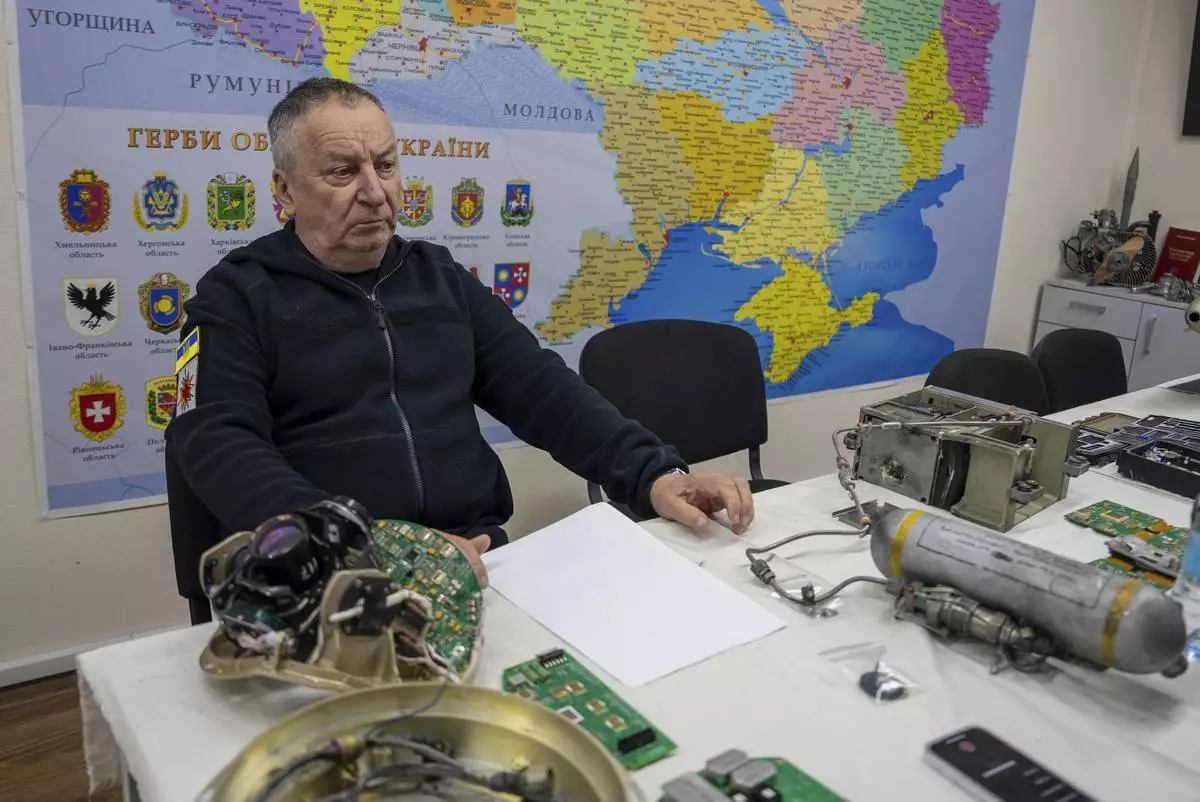
Andrii Kulchytskyi the head of the military research laboratory at the Kyiv Scientific Research Institute of Forensic Expertise sits in his workspace in Kyiv, Ukraine, Tuesday, Oct. 15, 2024. (AP Photo/Alex Babenko)
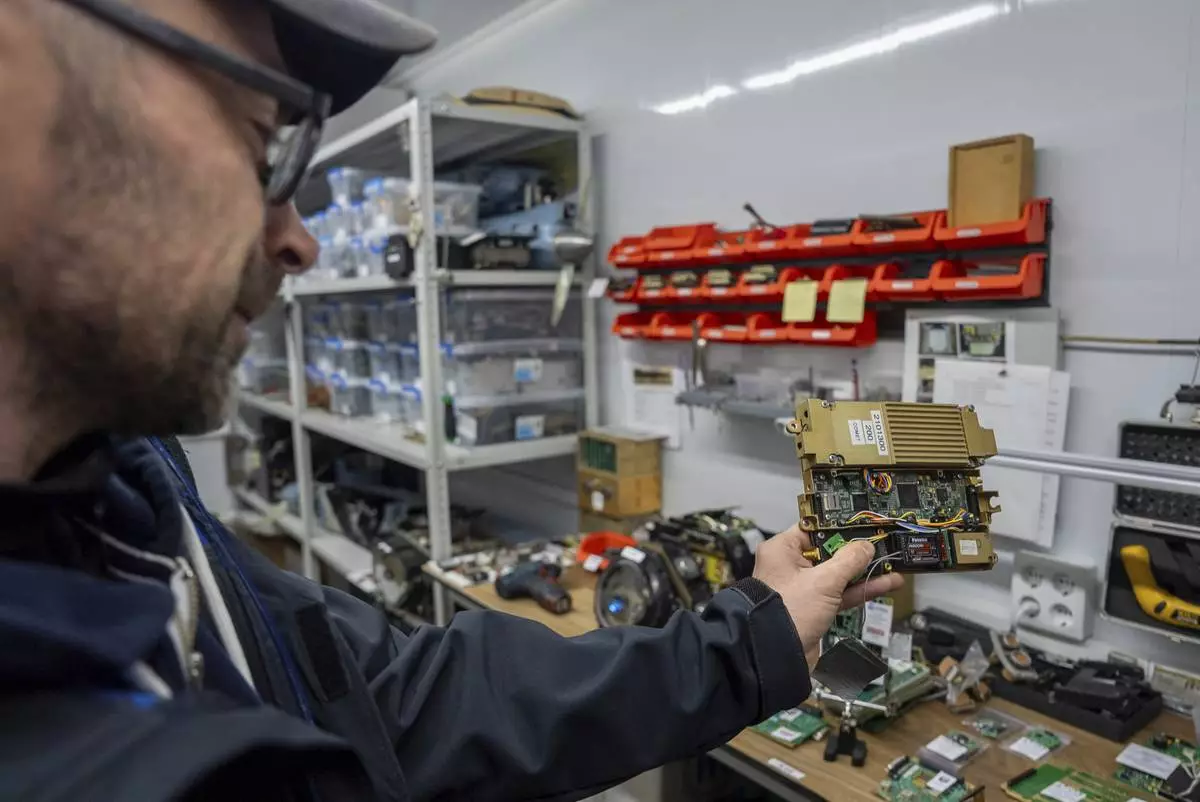
A worker of the Kyiv Scientific Research Institute of Forensic Expertise shows parts of Russian weapons in Kyiv, Ukraine, Tuesday, Oct. 15, 2024. (AP Photo/Alex Babenko)
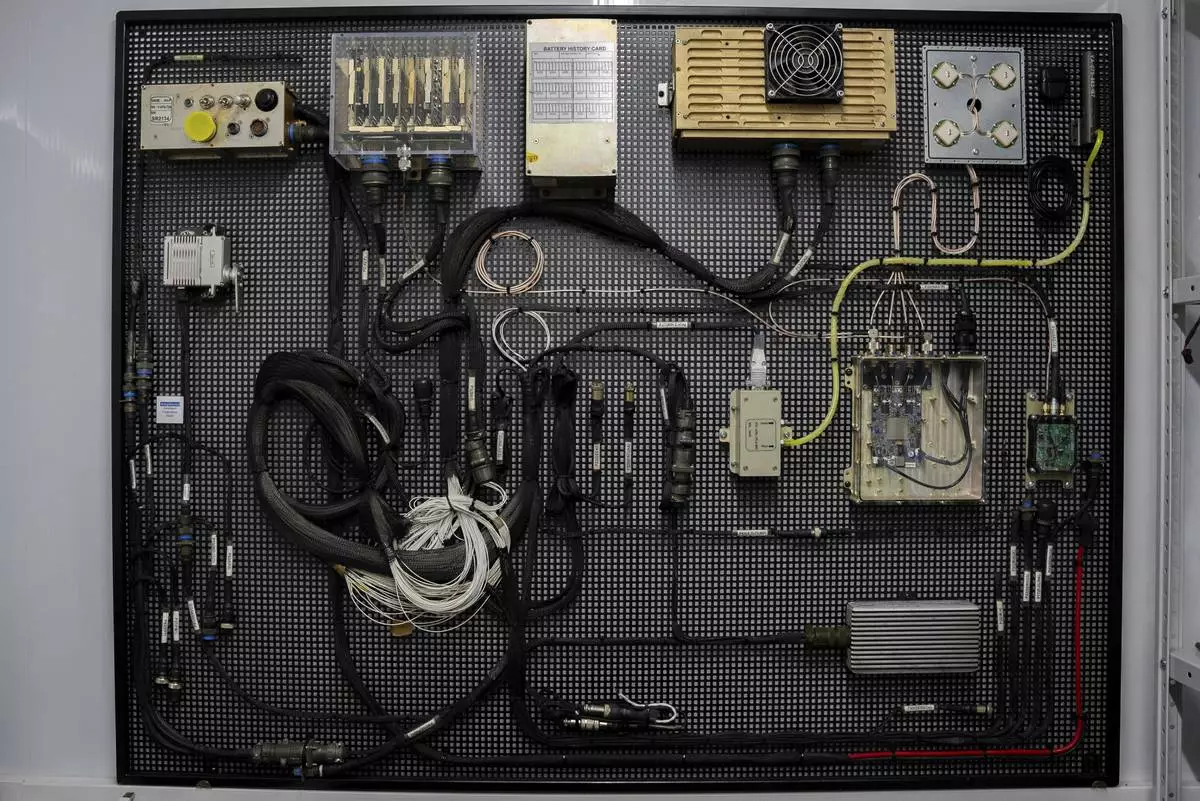
The internal mechanism of Shahed drone is seen in Kyiv Scientific Research Institute of Forensic Expertise in Kyiv, Ukraine, Tuesday, Oct. 15, 2024. (AP Photo/Alex Babenko)
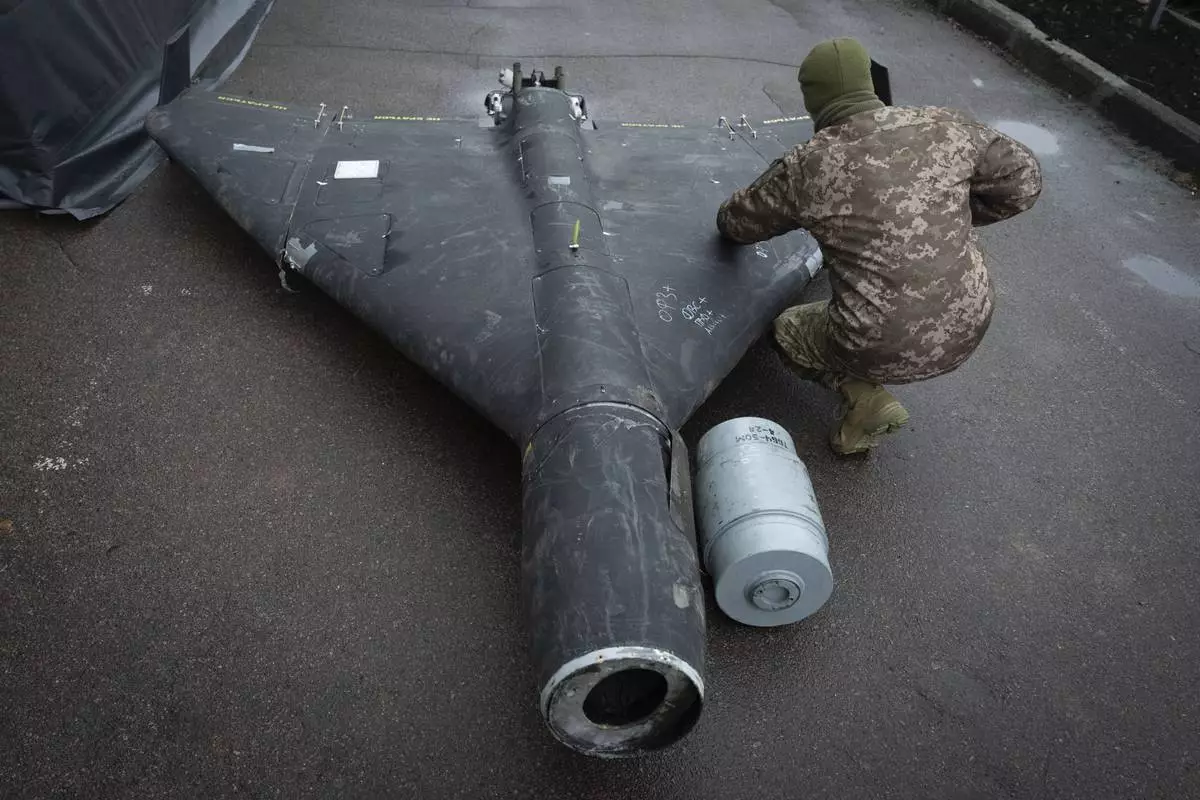
A Ukrainian officer examines a downed Shahed drone with thermobaric charge launched by Russia in a research laboratory in an undisclosed location in Ukraine Thursday, Nov. 14, 2024. (AP Photo/Efrem Lukatsky)
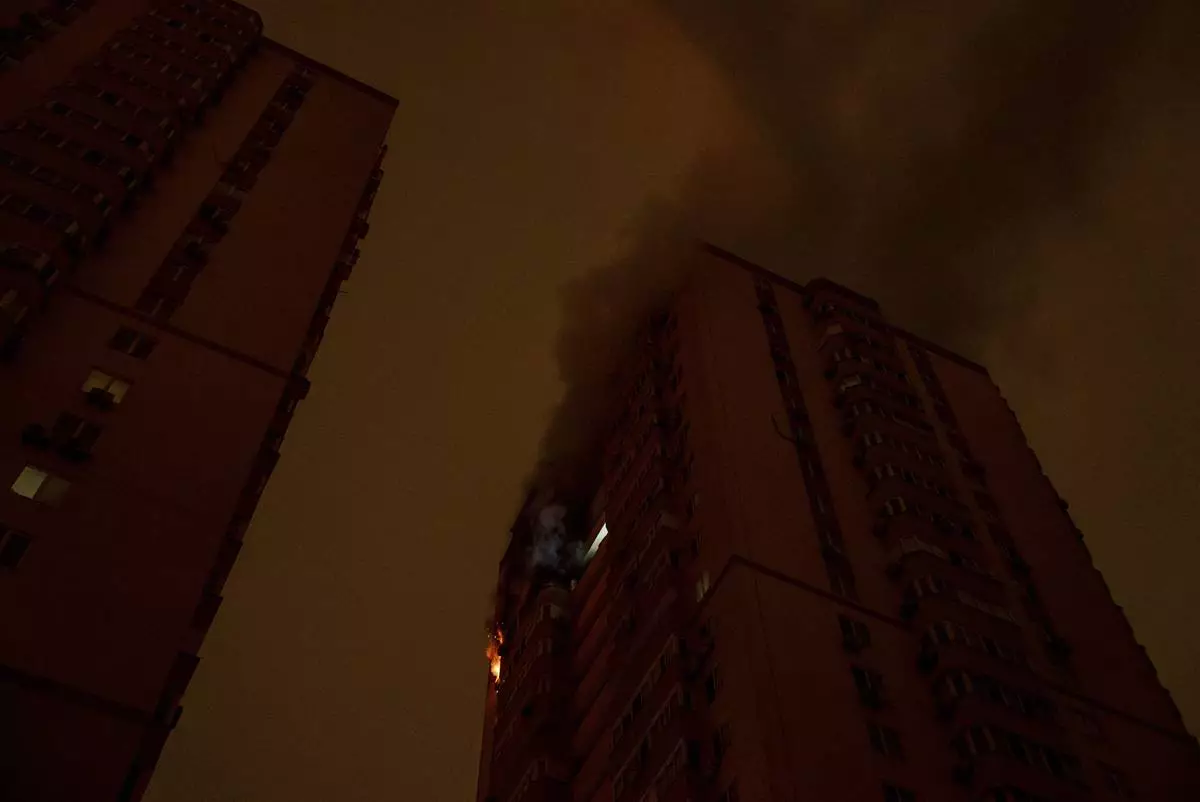
Flames and smoke rise from a residential building after the attack of Russian drones in Kyiv, Ukraine, Friday, Oct. 26, 2024. (AP Photo/Alex Babenko)
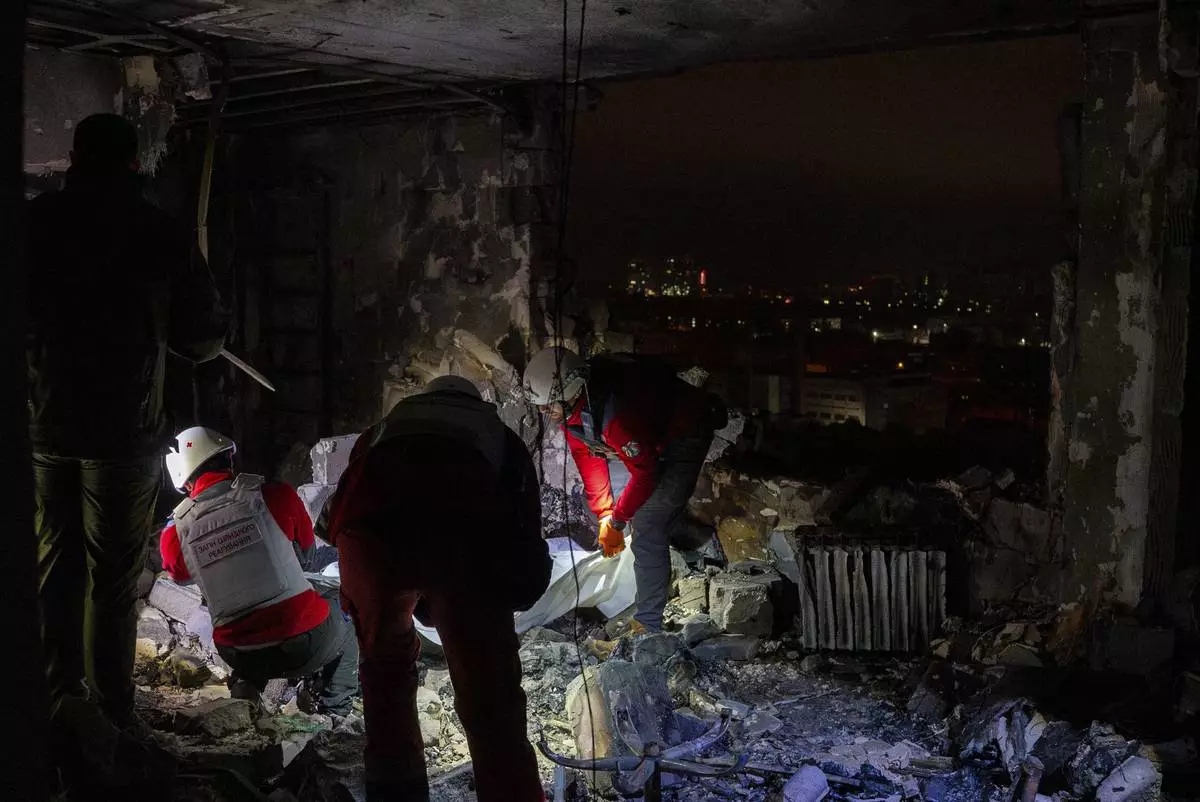
A medical emergency team collects the body of a victim who died after the Russian attack in Kyiv, Ukraine, Friday, Oct. 26, 2024. (AP Photo/Alex Babenko)

A Ukrainian officer, callsign Raccoon, shows a thermobaric charge of a downed Shahed drone launched by Russia in a research laboratory in an undisclosed location in Ukraine Thursday, Nov. 14, 2024. (AP Photo/Efrem Lukatsky)
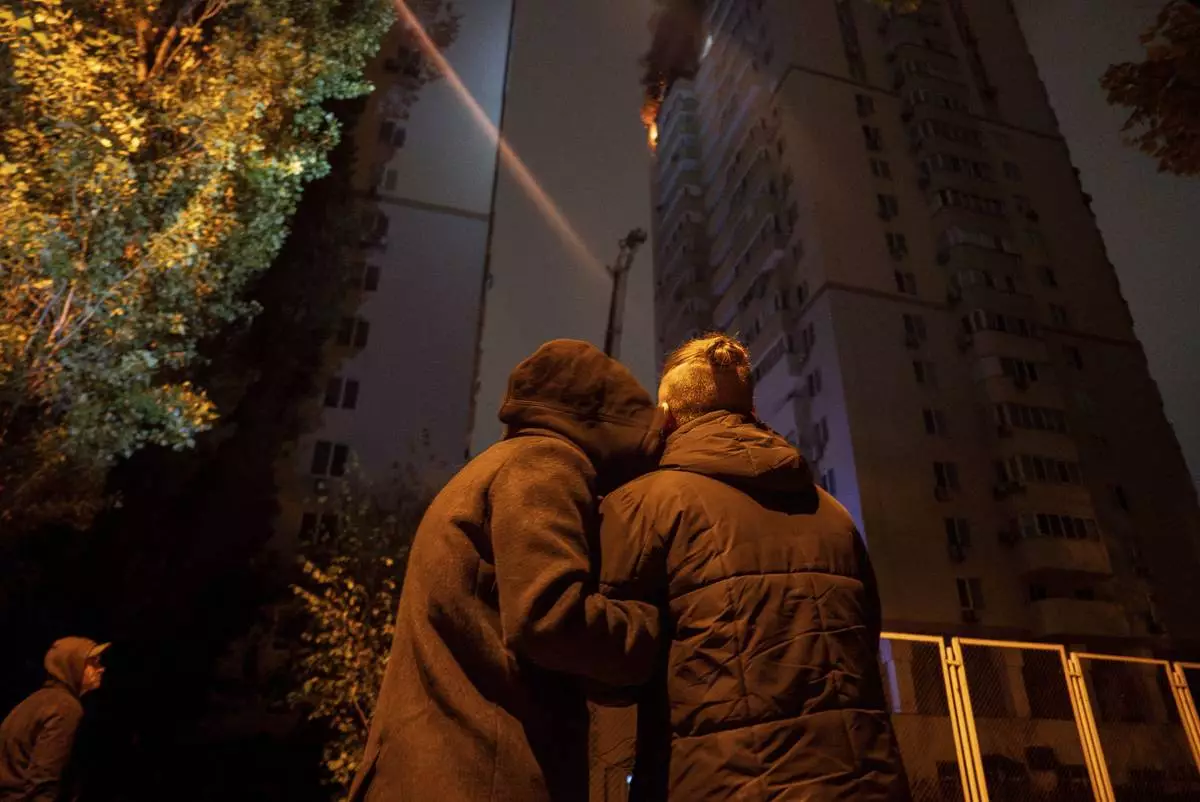
A couple comforts each other while looking at the fire in a residential building after the attack of Russian drones in Kyiv, Ukraine, Friday, Oct. 26, 2024. (AP Photo/Alex Babenko)
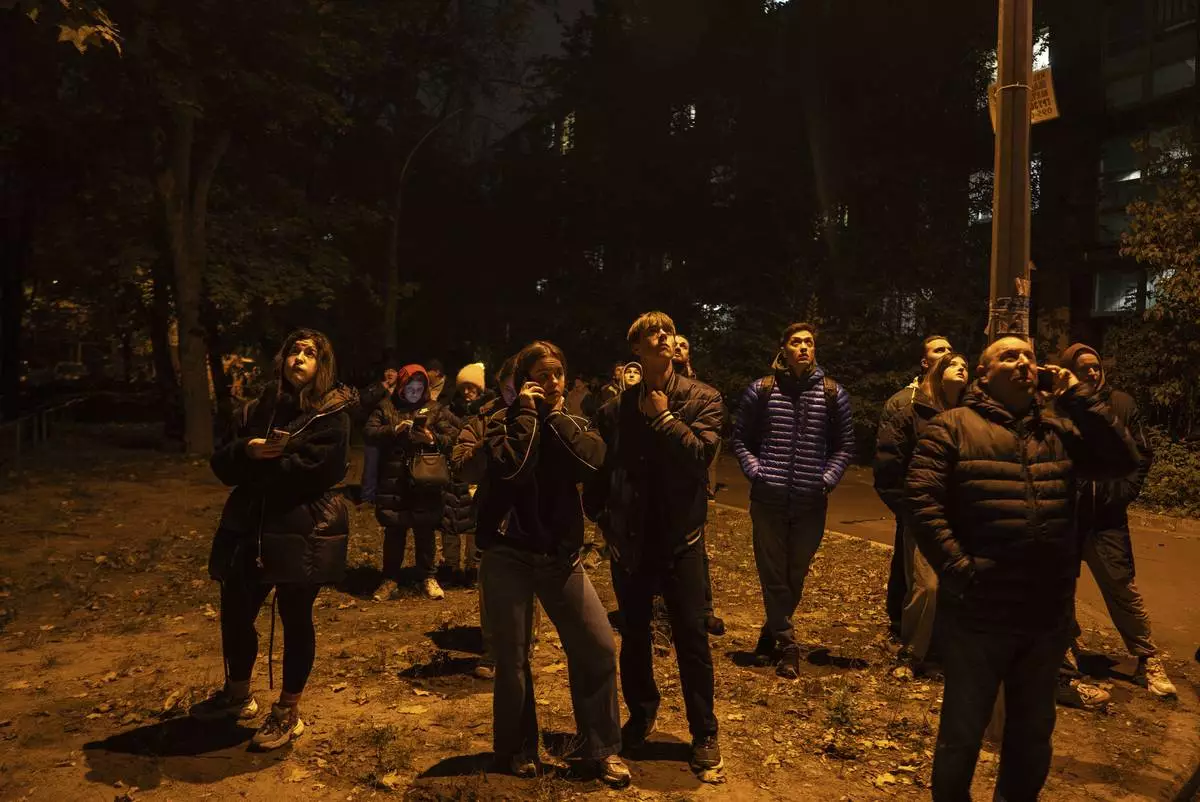
Local residents look up at the fire in a residential building after an attack of Russian drones in Kyiv, Ukraine, Friday, Oct. 26, 2024. (AP Photo/Alex Babenko)
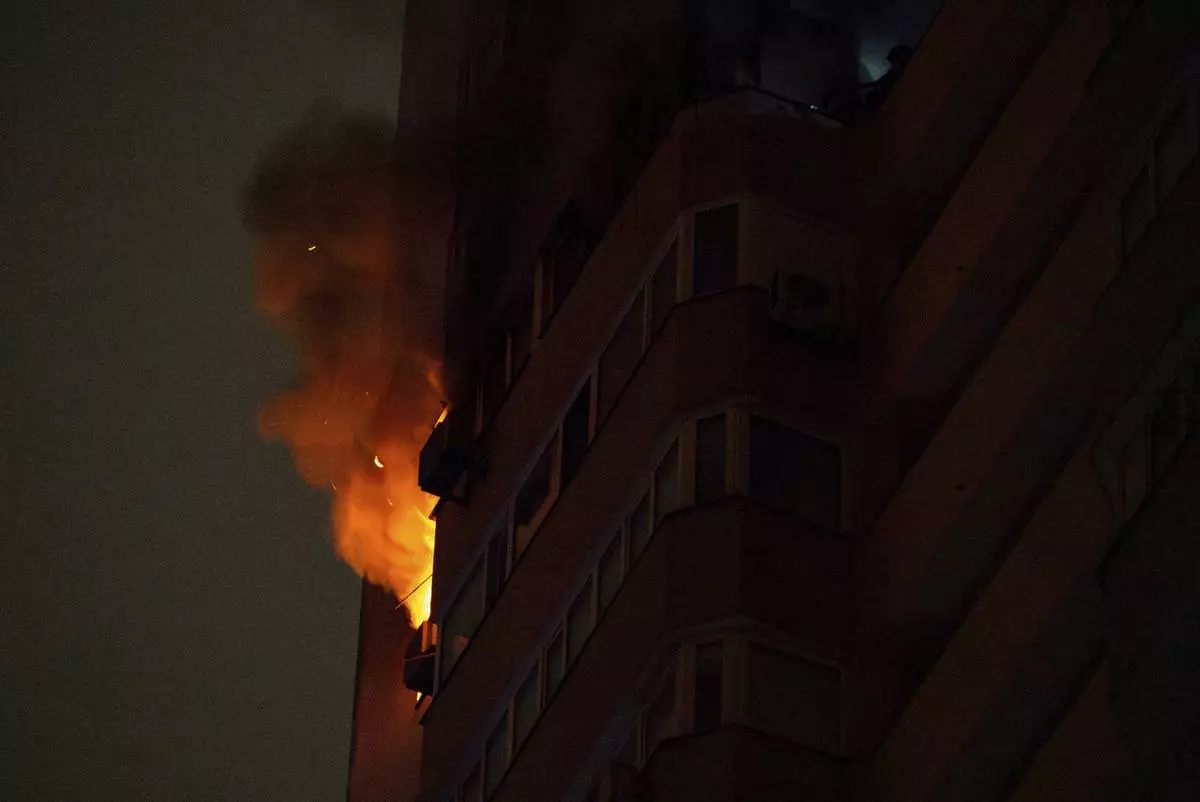
Flames and smoke rise from a residential building after the attack of Russian drones in Kyiv, Ukraine, Friday, Oct. 26, 2024. (AP Photo/Alex Babenko)
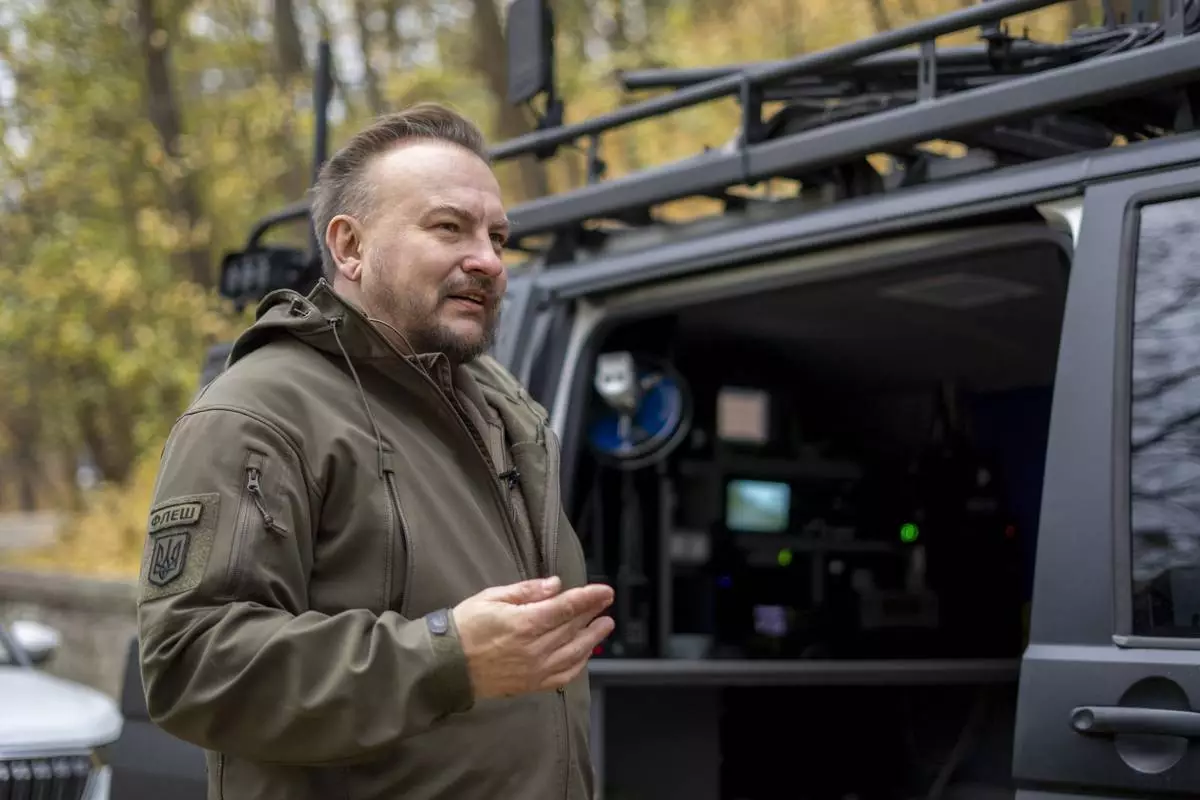
Serhii Beskrestnov, more widely known as Flash, a Ukrainian electronics expert, who hunts drones for the military, stands near his kitted-out black van in Kyiv, Ukraine, Monday, Nov. 4, 2024. (AP Photo/Hanna Arhirova)
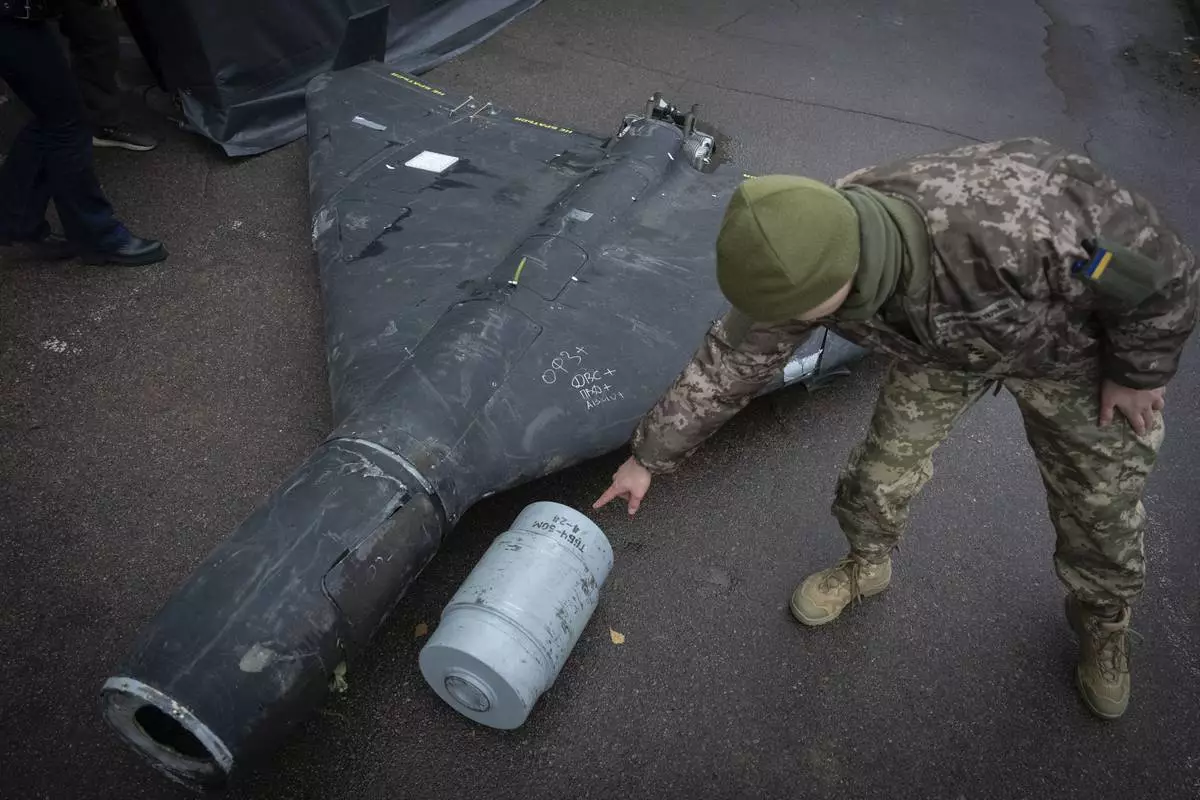
A Ukrainian officer shows a thermobaric charge of a downed Shahed drone launched by Russia in a research laboratory in an undisclosed location in Ukraine Thursday, Nov. 14, 2024. (AP Photo/Efrem Lukatsky)



























